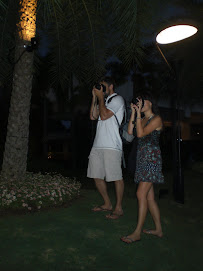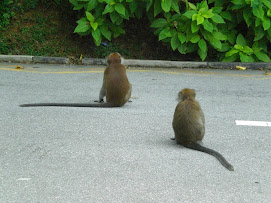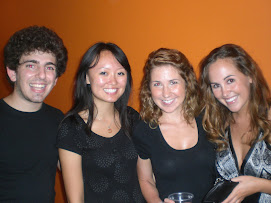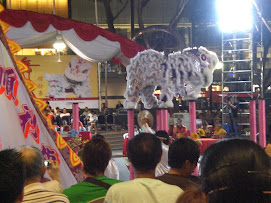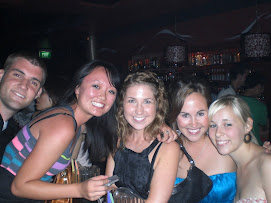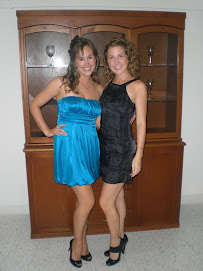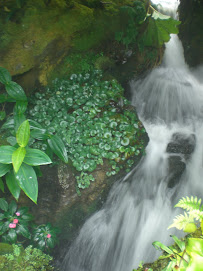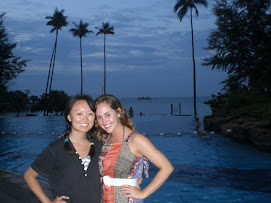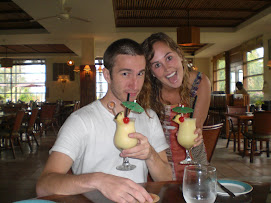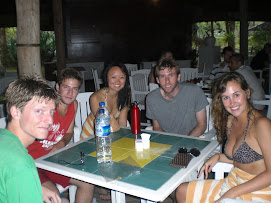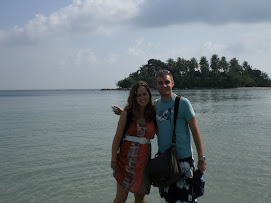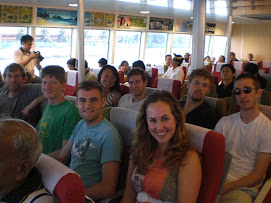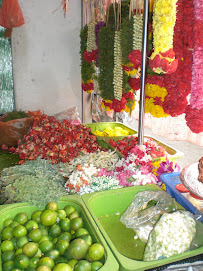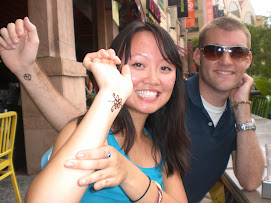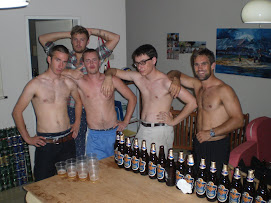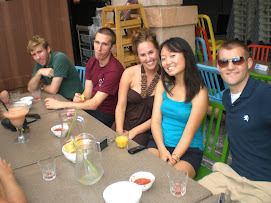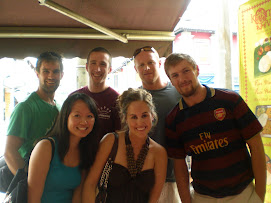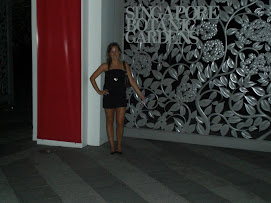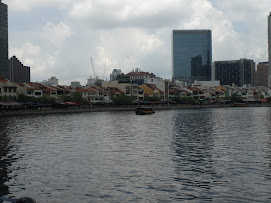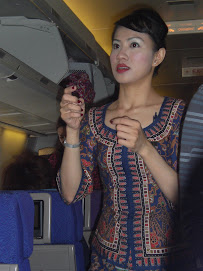Monday, November 8, 2010
Bon Voyage
“Someday soon this won’t be normal anymore,” Stephanie observed glancing up momentarily from her plate of white rice, oily vegetables, and saucy mystery meat, fork and spoon gesturing conductor-like to our surroundings.
I began to take in the environment more carefully: a stout Chinese woman shouting shrilly at her son over the clang of metal spatulas tapping metal woks; an old, glassy-eyed uncle without a shirt or shoes sipping what must have been his fifth Tiger of the early evening; a timid, petite girl stealing shy glimpses our way while chopping hot red peppers to make the kind of sauce that clears your sinuses when you look at it; a beer girl, just passed her prime, wandering between crowded, yellowing plastic tables and chairs. “When did all this become normal?” I wondered, racking my brain for the exact moment when I walked passed one of the outdoor food courts, which often smell of fish insides and curry spices, and didn’t bat an eye.
But here I am, 14 months beyond my first Hawker center experience when I sat poking balls of white fluff with an awkwardly held chopstick in an effort to reveal whether the inside stuffing looked edible or not (I have since discovered that these snow-ball like pastries filled with anything from pork to lotus to red bean are called bao). And I haven’t once thought about the pungent smells of the seafood stall, the kind of health code violations that my dad would probably spot in the kitchen of the stall from which I ordered my mixed vegetable rice, or the sweat trickling down my lower back, the heat of the night amplified by the cooking fires and the close proximity of people. I then look down at my own plate and realize, in true Singaporean fashion, I’ve subconsciously grabbed my spoon with my right hand and am using my fork to scoop the food onto the spoon before eating off the spoon only. It is considered impolite to put the fork in your mouth.
All this, the thoughts, the sensations, the realizations, happens in a fleeting moment. I look at Steph, shake my head, roll my eyes, and smile an understanding smile that slowly fades as we lean back in our chairs lost in our own thoughts. “When did all this become normal?”
It is hard to believe at this moment that those people and things which have become such a normal part of my everyday life in Singapore will soon again be exotic, strange, a memory. It is even more difficult to believe that that which used to be normal in my life in America will probably, at first, seem exotic, strange, a memory re-incarnated.
So, I guess what I am trying to say as I prepare to return to America is: please bear with me when I walk into Super WalMart and nearly burst into tears, because everything I need is all in one location. Please bear with me when I have a craving for Indian food and scoff at the Mexican I’ve been craving all year in Singapore, because Little India has been just a train ride away. Please bear with me when I turn into a lane of oncoming traffic, because I’ve been riding on the other side of the rode. Please bear with me when I ask you to explain once again why we can’t go to the beach in January, because I have been living a three-hour plane ride from Bali. Please bear with me when I walk snottily passed every Chinese restaurant in the food court, because it is not real Chinese food. Please bear with me when I say a phrase that sounds like English but you cannot really fully understand what I mean, because I have been speaking primarily to Singaporean adolescents all year. Please bear with me when I complain about how cold I am, because I have been living in a sauna. Please bear with me when I speak of the foods, cultures, histories and geographies of Southeast Asian countries as if everyone should know and relate to what I’m talking about, because I’ve learned a lot this year and it is all incredibly interesting to me. Please bare with me as I readjust to life in America, because they say reverse culture shock is often worse than its predecessor.
But, to lighten the culture shock blow a bit, for the next five weeks I will be on a vacation adventure which should leave me, while quite happy, exhausted and ready to return home for Christmas. As I make my way across Myanmar, India, Bangkok, Laos and Vietnam, I look forward to the final surprises Asia has left in store for me.
For now, I am packing my life into a backpack and three suitcases and enjoying my last views of the Singapore skyline, my last picnics in the botanical gardens, my last farewells with my students and friends ,and my last Hawker Center meals. You’ve been good to me…bon voyage Singapore!
TIA,
Rachel
I began to take in the environment more carefully: a stout Chinese woman shouting shrilly at her son over the clang of metal spatulas tapping metal woks; an old, glassy-eyed uncle without a shirt or shoes sipping what must have been his fifth Tiger of the early evening; a timid, petite girl stealing shy glimpses our way while chopping hot red peppers to make the kind of sauce that clears your sinuses when you look at it; a beer girl, just passed her prime, wandering between crowded, yellowing plastic tables and chairs. “When did all this become normal?” I wondered, racking my brain for the exact moment when I walked passed one of the outdoor food courts, which often smell of fish insides and curry spices, and didn’t bat an eye.
But here I am, 14 months beyond my first Hawker center experience when I sat poking balls of white fluff with an awkwardly held chopstick in an effort to reveal whether the inside stuffing looked edible or not (I have since discovered that these snow-ball like pastries filled with anything from pork to lotus to red bean are called bao). And I haven’t once thought about the pungent smells of the seafood stall, the kind of health code violations that my dad would probably spot in the kitchen of the stall from which I ordered my mixed vegetable rice, or the sweat trickling down my lower back, the heat of the night amplified by the cooking fires and the close proximity of people. I then look down at my own plate and realize, in true Singaporean fashion, I’ve subconsciously grabbed my spoon with my right hand and am using my fork to scoop the food onto the spoon before eating off the spoon only. It is considered impolite to put the fork in your mouth.
All this, the thoughts, the sensations, the realizations, happens in a fleeting moment. I look at Steph, shake my head, roll my eyes, and smile an understanding smile that slowly fades as we lean back in our chairs lost in our own thoughts. “When did all this become normal?”
It is hard to believe at this moment that those people and things which have become such a normal part of my everyday life in Singapore will soon again be exotic, strange, a memory. It is even more difficult to believe that that which used to be normal in my life in America will probably, at first, seem exotic, strange, a memory re-incarnated.
So, I guess what I am trying to say as I prepare to return to America is: please bear with me when I walk into Super WalMart and nearly burst into tears, because everything I need is all in one location. Please bear with me when I have a craving for Indian food and scoff at the Mexican I’ve been craving all year in Singapore, because Little India has been just a train ride away. Please bear with me when I turn into a lane of oncoming traffic, because I’ve been riding on the other side of the rode. Please bear with me when I ask you to explain once again why we can’t go to the beach in January, because I have been living a three-hour plane ride from Bali. Please bear with me when I walk snottily passed every Chinese restaurant in the food court, because it is not real Chinese food. Please bear with me when I say a phrase that sounds like English but you cannot really fully understand what I mean, because I have been speaking primarily to Singaporean adolescents all year. Please bear with me when I complain about how cold I am, because I have been living in a sauna. Please bear with me when I speak of the foods, cultures, histories and geographies of Southeast Asian countries as if everyone should know and relate to what I’m talking about, because I’ve learned a lot this year and it is all incredibly interesting to me. Please bare with me as I readjust to life in America, because they say reverse culture shock is often worse than its predecessor.
But, to lighten the culture shock blow a bit, for the next five weeks I will be on a vacation adventure which should leave me, while quite happy, exhausted and ready to return home for Christmas. As I make my way across Myanmar, India, Bangkok, Laos and Vietnam, I look forward to the final surprises Asia has left in store for me.
For now, I am packing my life into a backpack and three suitcases and enjoying my last views of the Singapore skyline, my last picnics in the botanical gardens, my last farewells with my students and friends ,and my last Hawker Center meals. You’ve been good to me…bon voyage Singapore!
TIA,
Rachel
Wednesday, October 20, 2010
Longing for a cowboy and a mahogany horse
A lone cowboy on a mahogany horse gallops at full speed across a pure blue and golden-wheat colored canvas. I can feel the velvet Earth under my bare feet. The world smells of dust and an impending rain. I have been here many times before.
It is a summer morning in a South Dakota prairie town. It is a crisp fall afternoon enveloping the Wyoming grasslands in a gentle embrace. It is an endless drive home across the Nebraska pastures.
In reality, I am staring at, well who am I kidding, I am practically hypnotized by a picture in the October 2010 issue of "National Geographic" magazine taken in West Texas in 1974. I have never actually been there, yet I have many times.
In the article, entitled “Under the Big Sky” the author describes a morning in Wyoming "the first light on high mountain meadows, the wisps of clouds within my reach,” and I can see the place.
He goes on to say, “I suppose we all feel more restricted today. There seem to be gates in our lives that we never get open. But if we’re lucky, we find a special place to us. Even though it may change with time, if we love it deeply enough, there is a part of it within us to the end.” To me, this is the American Midwest.
It is probably inevitable that as my time in Asia dwindles, I begin to dream of frost covered winter mornings, proud, graceful deer hopping metronomic-ally over wind-torn fences, and oceans of brown, green, and tan that wave on seemingly endlessly into nothingness until they kiss the sky. Yet, I also like to think that when I look back on my time in Singapore, I will find that the breathtakingly powerful tropical thunderstorms, the hiss of cool oil on hot woks, the palm-tree framed balmy sunsets, and the anxious, rhythmic dance of the public transportation system have also occupied such a special place in my heart that they have become a part of me as well.
So, of course, in between marking in the last few weeks, I have set out to make the most of these now limited days.
Steph and I spent one night on a legitimate night safari (not the one at the zoo…although I wouldn’t exactly call that night safari illegitimate either considering the fire dancers) with a camera crew on a special expedition inside Bukit Timah nature reserve to spot the creatures who lurk and crawl when human activity ceases after dark. Among our finds: snakes, spiders, scorpions, and bugs I never want to see again. Our lucky, and thoroughly undeserved, participation in the tour was due to a previously mentioned 15-minutes-of-fame experience when Steph and I were photographed at another nature reserve and subsequently published in a photographer/author/dentist-by-day’s book. Through this connection, we were given the opportunity to accompany this group of photographers and nature researchers into the “wild.”
I also spent one day as the subject of a photo shoot, though not one for a nature magazine this time, when my friend Will and his faithful assistant, Stephanie, helped me to take headshots and body shots: think senior photos but with far less pressure due to the lack of the wallet-sized versions, which may come back to haunt you for the rest of your life in the form high school reunions.
I have spent some quality time bonding with my colleagues and my new roommate cum colleague, Victoria, eating out for Mexican and, as a neighbor of the cuisine’s home country, subsequently ordering for everyone; enjoying an a cappella concert inclusive of a “Grease” mix during which I could not help but picture my dad as a little boy dancing as Danny on the couch…I mean hood of a chick-magnet car…; celebrating the end of Hari Raya, which marks the end of the fasting month for my Muslim friends; and whipping up a multi-cultural salad day feast for our English-department hosted lunch at school.
In keeping with the variety-show that is my life, Sarah, Steph, Kurt, and I even went to a Sunday morning brunch at an equestrian training and horse stabling turf club which felt more like a ranch in Pennsylvania than a restaurant in tropical Singapore. And, Steph, Victoria, Yui Yun, and I rode the train, which is due to officially close in June 2011, ladies-who-lunch-style over the boarder to Malaysia for pedicures and shopping one Saturday afternoon.
Now that my marking is done, I am busying myself with a mini-musical on which I have been working with one of my classes this semester as well as trying not to think about having to say goodbye to them. This ordeal is made all the more challenging when they throw me a “surprise” (not overly uncharacteristically, one of them accidently told me) goodbye party complete with a Barbie-doll pink cake, a frosting fight, and a rousing rendition of “We Love You Miss Rachel.”
For now, I have resolved to live in every moment, to love even my final highs and lows, and to put away the National Geographic picture at which I have been so longingly gazing for the last couple hours.
Cheers to my last three weeks in Singapore,
Rachel
It is a summer morning in a South Dakota prairie town. It is a crisp fall afternoon enveloping the Wyoming grasslands in a gentle embrace. It is an endless drive home across the Nebraska pastures.
In reality, I am staring at, well who am I kidding, I am practically hypnotized by a picture in the October 2010 issue of "National Geographic" magazine taken in West Texas in 1974. I have never actually been there, yet I have many times.
In the article, entitled “Under the Big Sky” the author describes a morning in Wyoming "the first light on high mountain meadows, the wisps of clouds within my reach,” and I can see the place.
He goes on to say, “I suppose we all feel more restricted today. There seem to be gates in our lives that we never get open. But if we’re lucky, we find a special place to us. Even though it may change with time, if we love it deeply enough, there is a part of it within us to the end.” To me, this is the American Midwest.
It is probably inevitable that as my time in Asia dwindles, I begin to dream of frost covered winter mornings, proud, graceful deer hopping metronomic-ally over wind-torn fences, and oceans of brown, green, and tan that wave on seemingly endlessly into nothingness until they kiss the sky. Yet, I also like to think that when I look back on my time in Singapore, I will find that the breathtakingly powerful tropical thunderstorms, the hiss of cool oil on hot woks, the palm-tree framed balmy sunsets, and the anxious, rhythmic dance of the public transportation system have also occupied such a special place in my heart that they have become a part of me as well.
So, of course, in between marking in the last few weeks, I have set out to make the most of these now limited days.
Steph and I spent one night on a legitimate night safari (not the one at the zoo…although I wouldn’t exactly call that night safari illegitimate either considering the fire dancers) with a camera crew on a special expedition inside Bukit Timah nature reserve to spot the creatures who lurk and crawl when human activity ceases after dark. Among our finds: snakes, spiders, scorpions, and bugs I never want to see again. Our lucky, and thoroughly undeserved, participation in the tour was due to a previously mentioned 15-minutes-of-fame experience when Steph and I were photographed at another nature reserve and subsequently published in a photographer/author/dentist-by-day’s book. Through this connection, we were given the opportunity to accompany this group of photographers and nature researchers into the “wild.”
I also spent one day as the subject of a photo shoot, though not one for a nature magazine this time, when my friend Will and his faithful assistant, Stephanie, helped me to take headshots and body shots: think senior photos but with far less pressure due to the lack of the wallet-sized versions, which may come back to haunt you for the rest of your life in the form high school reunions.
I have spent some quality time bonding with my colleagues and my new roommate cum colleague, Victoria, eating out for Mexican and, as a neighbor of the cuisine’s home country, subsequently ordering for everyone; enjoying an a cappella concert inclusive of a “Grease” mix during which I could not help but picture my dad as a little boy dancing as Danny on the couch…I mean hood of a chick-magnet car…; celebrating the end of Hari Raya, which marks the end of the fasting month for my Muslim friends; and whipping up a multi-cultural salad day feast for our English-department hosted lunch at school.
In keeping with the variety-show that is my life, Sarah, Steph, Kurt, and I even went to a Sunday morning brunch at an equestrian training and horse stabling turf club which felt more like a ranch in Pennsylvania than a restaurant in tropical Singapore. And, Steph, Victoria, Yui Yun, and I rode the train, which is due to officially close in June 2011, ladies-who-lunch-style over the boarder to Malaysia for pedicures and shopping one Saturday afternoon.
Now that my marking is done, I am busying myself with a mini-musical on which I have been working with one of my classes this semester as well as trying not to think about having to say goodbye to them. This ordeal is made all the more challenging when they throw me a “surprise” (not overly uncharacteristically, one of them accidently told me) goodbye party complete with a Barbie-doll pink cake, a frosting fight, and a rousing rendition of “We Love You Miss Rachel.”
For now, I have resolved to live in every moment, to love even my final highs and lows, and to put away the National Geographic picture at which I have been so longingly gazing for the last couple hours.
Cheers to my last three weeks in Singapore,
Rachel
Tuesday, September 21, 2010
My life on a bus
Before the countdown: It is 8:30 a.m. at the airport in Jakarta, Indonesia. I arrive a bit blurry-eyed due to my 5:30 a.m. wake-up call, but I have a naïve spring in my step none-the-less.
Hour one: I have taken a $.50 bus ride to the train station in the city center. I spent most of the ride marveling at the overlapping free-ways, sparkling high rise buildings, fancy SUVs, international-class hotels and restaurants, and the man next to me who is typing on three black-berries simultaneously that make this city of 10 million feel more like New York than Indonesia.
Hour one point two-five: It is September 8th. It is 9:45 a.m. The next available train ticket to Yogyakarta, the city which is to be my final destination, is for September 10th at 8 p.m. Plan B.
Hour one point five: I am arguing with a man about whether a cab to the bus station should cost 70,000 rupiah or 50,000 rupiah. I realize I am actually arguing with a man about whether a cab to the bus station should cost $7 or $5. Screw it. I’ll settle on six and a half.
Hour two: I arrive at the bus station, sweaty, breathless, and with much less spring in my step, after risking my life to cross a major bus-filled highway on foot. I paid the man 65,000 rupiah to drive me here and he “cannot pull into the station, cabs not allowed.” I see a cab stop in front of the station. The couple that gets out is neither sweaty nor breathless. I should have paid him 70,000.
Hour two point five: I have managed to find the one person who speaks English in the crowd of thousands lining up to get on tens of buses. She leads me to a bus that she promises will take me to Yogyakarta. The bus is empty. She leaves. It is 11 a.m.
Hour two point seven-five: It is 11:15. I am alone on a bus, which I think is going to Yogyakarta, but I am not really sure. I have no ticket. There is no air-conditioning. I’m not sure if the bus even runs. I think I better find the English-speaking woman.
Hour four: The woman has sold me a ticket. The bus leaves at 2 p.m. In the meantime, I have eaten a box of chocolate-covered strawberry filled cookies and am working on my second course…something called cheese cookies and what looks like a juice box of tea. A very small, very happy graying Indonesian man is telling me that he is an English teacher at a local school and would like to practice conversation. We are standing amidst the exhaust fumes of thirty buses and are surrounded by crowds of sweaty people straining to hear bus numbers which are simply shouted out over the din by young boys in blue button-ups. No one except my bus mistress, my enthusiastic English-teaching friend, and I speak English. I am quite amused.
Hour five: It is 1:30 in the afternoon. I have boarded the bus. Everyone else, including my somewhat large and hairy seatmate, has boarded also. It takes me a good ten minutes to shove my backpack under my seat. I have the window seat. My seatmate doesn’t move when I do this. I finally sit down and heave a sigh of relief. Everyone on the bus is staring at me. I stare back. So do they. So, this is what it feels like to be in a fishbowl.
Hour five and one quarter: A woman's seat is broken. It leans back too far. One of our bus drivers grabs a metal pole from who know where and shoves is through the arm rests at the back of the seat. Problem solved.
Hour five point five: We should be leaving soon. It is 2 p.m. The mother with her seven-year-old child sitting across from me has managed to mime that she likes my nose because it is pointy. She has also “told” me that her son’s is no good. It is too flat. Now everyone is staring at my pointy nose. Some even lean in for a closer look. Thank you Knutson genes.
Hour five and three quarters: I am marking some papers I have brought along with to kill the time. I have a rotating audience looking over my shoulder. They can’t possibly be interested in my student’s English papers, so I blame my pointy nose. People occasionally board the bus to sell things like fresh duck eggs, rice meals, mixed nuts, and sunglasses. One man trades me a bottle of water for a July issue of Time. Now, if he ever sees another person who speaks English, he will have something to sell to them.
Hour six point five: The bus is leaving. We are an hour late. We should arrive in Yogya in twelve hours.
Hour eight and a half: It is 5 p.m. We might still be in the suburbs of Jakarta. I have finished two issues of Time cover to cover…including that small print at the bottom of all the advertisements. We are maybe driving twenty miles per hour. I remember a New York Times article that I casually read last week.
“During the last days of Ramadan, the Islamic month of fasting, tens of millions of Indonesians leave the country’s cities to return to their villages by motorcycle, train, bus and boat. The mass homecoming is both a decidedly Indonesian interpretation of the Muslim holiday and one of the world’s great movements of people. On a road network whose capacity is strained at the best of times, travellers brave enormous jams, exhaustion and bandits to make it back home.”
I am literally a part of the second largest temporary migration of people in the world…thirty million plus one. At least the air conditioning works.
Hour eight point seven-five: The air conditioning has stopped working.
Hour nine point five: The sun is setting. The villages that are passing slowly by become a swirl of sunset oranges and soft yellows. The people are smiling and celebrating in their roadside stalls. They are beautiful. I watch them.
Hour eleven: I am not really sure if I have been sleeping or awake. Probably both.
Hour twelve: We stop for dinner. I avoid the rice and vegetable and chicken mixtures that are swarming with flies. It might be safer to eat packaged food. Besides, I want to avoid that bus bathroom as much as possible. Dried bananas, cashews, and puff pastry it is.
Hour thirteen: I don’t know if you can imagine what it feels like to be on hour seven in a traffic jam that stretches across an entire country, on a bus that is moving twenty miles per hour, with people you can’t even talk to because you don’t speak the same language, but, if you can’t, don’t try it.
Hour fifteen: The bus broke down. We are in the middle of a highway in a massive traffic jam and the bus broke down. We have been in a bus for eight and a half hours and the bus has just broken down. If I was less calm in the face of challenges, I might scream. Instead, I think I’ll hyperventilate.
Hour fifteen plus ten minutes: Our bus driver has calmly reignited the engine. Shadey at best. I have put away my paper bag. The air conditioning is working again.
Hour seventeen: It is 1:30 a.m. I have begun to make up stories about the flickers of light from the oncoming cars that reflect off the bus windows. They are about fireflies. This might be what it feels like to go crazy.
Hour eighteen and a half: The hairy man sitting next to me has been sleeping on my shoulder for the last hour. My arm is asleep. I don’t want to disturb him though, so I let my arm become all tingly, and I make up a story about it.
Hour nineteen: Something more exciting to distract me than my imagination: people have begun to pull off to the side of the road and light fireworks. I am being given my own private show. Little sparks of purple, blue, and red briefly illuminate the night sky. As a bonus, the bus picks up speed. I fall asleep with visions of fireworks dancing in my head and behind my eyelids.
Hour twenty-one point five: I open my eyes to find a smoking volcano appearing in the first purple light of day. We are navigating winding roads on the slopes of a jungle mountain, and the foliage has overgrown the road so that I can actually see the dew drops sliding off the pink and salmon petals of the tropical flowers in the canopy above. The rice patties in the distance are emerald green.
Hour twenty-two point five: The bus driver just told me we are about eight hours from Yogya. I have been on a bus for 16 hours.
Hour twenty three: My butt is completely asleep.
Hour twenty three point seven-five: I am doing yoga in the aisle. If my bus-mates didn’t think I was crazy before, they do now.
Hours twenty four to twenty eight: I finish my marking. I stretch a little. I make faces at the kids in buses we pass and they make faces back at me. I finish my remaining two Time magazines, and I use the Southeast Asia travel guide to plan my entire November/December holiday. We pass through endless plains of brilliant green rice patties. I play games on my phone with the kid whose mom thinks his nose is too flat. I let my seatmate sleep on my shoulder…again. Time passes.
Hour twenty eight and one quarter: People are restless. We have been on a bus for twenty one hours and forty five minutes. The traffic is ridiculous. I feel a bit like I am at the Sturgis motorcycle rally with fewer helmets, more rice fields, and a greater person to bike ratio. I do another round of yoga. People request pictures. I have a photo shoot with every family on the bus. My pointy nose is sure to make mantelpieces all over Java.
Hour twenty nine point five: It is 2 p.m. We are in the suburbs of Yogya. I can tell by the signs. We are starting to drop people off on various corners.
Hour thirty and a half: I arrive at the bus station. I have been on a bus for 24 hours. I have been attempting to get to Yogya for more than that. Nothing else matters now, though, because I am here, I am safe, I was a part of the second largest temporary land migration on the planet, and I had the experience of a lifetime.
Of course, the reminder of my trip was not nearly as much of a physical or emotional roller coaster. In fact, it was wonderful. But “pleasant” does not make for an interesting story. So here, I will simply relay the highlights of the rest of my trip.
Stephanie met me at our adorable bed and breakfast that evening (she had chosen to fly because she got out of school a day later…no comment). We spent our first full day in Yogya together walking along an old lava flow on Gunung Merapi, the most active volcano in Indonesia, hiking to caves made during the Japanese occupation, exploring the batik markets, and savoring some traditional Javanese beer and cuisine.
The second night was spent in a hostel on a rice patty where we were lulled to sleep underneath our mosquito net by the sound of croaking bull frogs just outside our windows. The highlight of the trip was the sunrise atop Borobudur temple where we watched the sun slowly unveil the volcano in the distance. Borobudur is both a Buddhist temple and a place for pilgrimage. According to Wikipedia, "the journey for pilgrims begins at the base of the monument and follows a path circulating the monument while ascending to the top through the three levels of Buddhist cosmology, namely Kāmadhātu (the world of desire), Rupadhatu (the world of forms) and Arupadhatu (the world of formlessness). During the journey the monument guides the pilgrims through a system of stairways and corridors with 1,460 narrative relief panels on the wall."
Our second afternoon was spent exploring Yogya on foot before we took the night train (a form of transport that actually only took eight hours due to the lack of traffic) back to Jakarta.
On Sunday, we immersed ourselves in the Hari Raya celebrations in Jakarta taking in street performances, enjoying cotton candy in the National Monument’s park, and watching locals “sort of” re-create the old-Dutch feel in the Dutch quarter by riding bicycles while wearing floppy hats within a perimeter. Our last moments in Jakarta were spent sipping coffee and eating gourmet Javanese food in a secret garden-esque restaurant.
Now that the September holidays are over, I have officially begun my final term of teaching in Singapore. For the next several weeks I will be lesson planning, marking final exams, finalizing forms, preparing for my end-of-contract travels, applying for graduate programs, and generally figuring out my future.
I have officially begun tackling my Singapore bucket list. I’ll keep you posted.
xoxo,
Rachel
http://picasaweb.google.com/rachelknutson.knutson8/InIndo#
http://picasaweb.google.com/rachelknutson.knutson8/SeptemberSurprisesAndSomeInAugustToo#
Hour one: I have taken a $.50 bus ride to the train station in the city center. I spent most of the ride marveling at the overlapping free-ways, sparkling high rise buildings, fancy SUVs, international-class hotels and restaurants, and the man next to me who is typing on three black-berries simultaneously that make this city of 10 million feel more like New York than Indonesia.
Hour one point two-five: It is September 8th. It is 9:45 a.m. The next available train ticket to Yogyakarta, the city which is to be my final destination, is for September 10th at 8 p.m. Plan B.
Hour one point five: I am arguing with a man about whether a cab to the bus station should cost 70,000 rupiah or 50,000 rupiah. I realize I am actually arguing with a man about whether a cab to the bus station should cost $7 or $5. Screw it. I’ll settle on six and a half.
Hour two: I arrive at the bus station, sweaty, breathless, and with much less spring in my step, after risking my life to cross a major bus-filled highway on foot. I paid the man 65,000 rupiah to drive me here and he “cannot pull into the station, cabs not allowed.” I see a cab stop in front of the station. The couple that gets out is neither sweaty nor breathless. I should have paid him 70,000.
Hour two point five: I have managed to find the one person who speaks English in the crowd of thousands lining up to get on tens of buses. She leads me to a bus that she promises will take me to Yogyakarta. The bus is empty. She leaves. It is 11 a.m.
Hour two point seven-five: It is 11:15. I am alone on a bus, which I think is going to Yogyakarta, but I am not really sure. I have no ticket. There is no air-conditioning. I’m not sure if the bus even runs. I think I better find the English-speaking woman.
Hour four: The woman has sold me a ticket. The bus leaves at 2 p.m. In the meantime, I have eaten a box of chocolate-covered strawberry filled cookies and am working on my second course…something called cheese cookies and what looks like a juice box of tea. A very small, very happy graying Indonesian man is telling me that he is an English teacher at a local school and would like to practice conversation. We are standing amidst the exhaust fumes of thirty buses and are surrounded by crowds of sweaty people straining to hear bus numbers which are simply shouted out over the din by young boys in blue button-ups. No one except my bus mistress, my enthusiastic English-teaching friend, and I speak English. I am quite amused.
Hour five: It is 1:30 in the afternoon. I have boarded the bus. Everyone else, including my somewhat large and hairy seatmate, has boarded also. It takes me a good ten minutes to shove my backpack under my seat. I have the window seat. My seatmate doesn’t move when I do this. I finally sit down and heave a sigh of relief. Everyone on the bus is staring at me. I stare back. So do they. So, this is what it feels like to be in a fishbowl.
Hour five and one quarter: A woman's seat is broken. It leans back too far. One of our bus drivers grabs a metal pole from who know where and shoves is through the arm rests at the back of the seat. Problem solved.
Hour five point five: We should be leaving soon. It is 2 p.m. The mother with her seven-year-old child sitting across from me has managed to mime that she likes my nose because it is pointy. She has also “told” me that her son’s is no good. It is too flat. Now everyone is staring at my pointy nose. Some even lean in for a closer look. Thank you Knutson genes.
Hour five and three quarters: I am marking some papers I have brought along with to kill the time. I have a rotating audience looking over my shoulder. They can’t possibly be interested in my student’s English papers, so I blame my pointy nose. People occasionally board the bus to sell things like fresh duck eggs, rice meals, mixed nuts, and sunglasses. One man trades me a bottle of water for a July issue of Time. Now, if he ever sees another person who speaks English, he will have something to sell to them.
Hour six point five: The bus is leaving. We are an hour late. We should arrive in Yogya in twelve hours.
Hour eight and a half: It is 5 p.m. We might still be in the suburbs of Jakarta. I have finished two issues of Time cover to cover…including that small print at the bottom of all the advertisements. We are maybe driving twenty miles per hour. I remember a New York Times article that I casually read last week.
“During the last days of Ramadan, the Islamic month of fasting, tens of millions of Indonesians leave the country’s cities to return to their villages by motorcycle, train, bus and boat. The mass homecoming is both a decidedly Indonesian interpretation of the Muslim holiday and one of the world’s great movements of people. On a road network whose capacity is strained at the best of times, travellers brave enormous jams, exhaustion and bandits to make it back home.”
I am literally a part of the second largest temporary migration of people in the world…thirty million plus one. At least the air conditioning works.
Hour eight point seven-five: The air conditioning has stopped working.
Hour nine point five: The sun is setting. The villages that are passing slowly by become a swirl of sunset oranges and soft yellows. The people are smiling and celebrating in their roadside stalls. They are beautiful. I watch them.
Hour eleven: I am not really sure if I have been sleeping or awake. Probably both.
Hour twelve: We stop for dinner. I avoid the rice and vegetable and chicken mixtures that are swarming with flies. It might be safer to eat packaged food. Besides, I want to avoid that bus bathroom as much as possible. Dried bananas, cashews, and puff pastry it is.
Hour thirteen: I don’t know if you can imagine what it feels like to be on hour seven in a traffic jam that stretches across an entire country, on a bus that is moving twenty miles per hour, with people you can’t even talk to because you don’t speak the same language, but, if you can’t, don’t try it.
Hour fifteen: The bus broke down. We are in the middle of a highway in a massive traffic jam and the bus broke down. We have been in a bus for eight and a half hours and the bus has just broken down. If I was less calm in the face of challenges, I might scream. Instead, I think I’ll hyperventilate.
Hour fifteen plus ten minutes: Our bus driver has calmly reignited the engine. Shadey at best. I have put away my paper bag. The air conditioning is working again.
Hour seventeen: It is 1:30 a.m. I have begun to make up stories about the flickers of light from the oncoming cars that reflect off the bus windows. They are about fireflies. This might be what it feels like to go crazy.
Hour eighteen and a half: The hairy man sitting next to me has been sleeping on my shoulder for the last hour. My arm is asleep. I don’t want to disturb him though, so I let my arm become all tingly, and I make up a story about it.
Hour nineteen: Something more exciting to distract me than my imagination: people have begun to pull off to the side of the road and light fireworks. I am being given my own private show. Little sparks of purple, blue, and red briefly illuminate the night sky. As a bonus, the bus picks up speed. I fall asleep with visions of fireworks dancing in my head and behind my eyelids.
Hour twenty-one point five: I open my eyes to find a smoking volcano appearing in the first purple light of day. We are navigating winding roads on the slopes of a jungle mountain, and the foliage has overgrown the road so that I can actually see the dew drops sliding off the pink and salmon petals of the tropical flowers in the canopy above. The rice patties in the distance are emerald green.
Hour twenty-two point five: The bus driver just told me we are about eight hours from Yogya. I have been on a bus for 16 hours.
Hour twenty three: My butt is completely asleep.
Hour twenty three point seven-five: I am doing yoga in the aisle. If my bus-mates didn’t think I was crazy before, they do now.
Hours twenty four to twenty eight: I finish my marking. I stretch a little. I make faces at the kids in buses we pass and they make faces back at me. I finish my remaining two Time magazines, and I use the Southeast Asia travel guide to plan my entire November/December holiday. We pass through endless plains of brilliant green rice patties. I play games on my phone with the kid whose mom thinks his nose is too flat. I let my seatmate sleep on my shoulder…again. Time passes.
Hour twenty eight and one quarter: People are restless. We have been on a bus for twenty one hours and forty five minutes. The traffic is ridiculous. I feel a bit like I am at the Sturgis motorcycle rally with fewer helmets, more rice fields, and a greater person to bike ratio. I do another round of yoga. People request pictures. I have a photo shoot with every family on the bus. My pointy nose is sure to make mantelpieces all over Java.
Hour twenty nine point five: It is 2 p.m. We are in the suburbs of Yogya. I can tell by the signs. We are starting to drop people off on various corners.
Hour thirty and a half: I arrive at the bus station. I have been on a bus for 24 hours. I have been attempting to get to Yogya for more than that. Nothing else matters now, though, because I am here, I am safe, I was a part of the second largest temporary land migration on the planet, and I had the experience of a lifetime.
Of course, the reminder of my trip was not nearly as much of a physical or emotional roller coaster. In fact, it was wonderful. But “pleasant” does not make for an interesting story. So here, I will simply relay the highlights of the rest of my trip.
Stephanie met me at our adorable bed and breakfast that evening (she had chosen to fly because she got out of school a day later…no comment). We spent our first full day in Yogya together walking along an old lava flow on Gunung Merapi, the most active volcano in Indonesia, hiking to caves made during the Japanese occupation, exploring the batik markets, and savoring some traditional Javanese beer and cuisine.
The second night was spent in a hostel on a rice patty where we were lulled to sleep underneath our mosquito net by the sound of croaking bull frogs just outside our windows. The highlight of the trip was the sunrise atop Borobudur temple where we watched the sun slowly unveil the volcano in the distance. Borobudur is both a Buddhist temple and a place for pilgrimage. According to Wikipedia, "the journey for pilgrims begins at the base of the monument and follows a path circulating the monument while ascending to the top through the three levels of Buddhist cosmology, namely Kāmadhātu (the world of desire), Rupadhatu (the world of forms) and Arupadhatu (the world of formlessness). During the journey the monument guides the pilgrims through a system of stairways and corridors with 1,460 narrative relief panels on the wall."
Our second afternoon was spent exploring Yogya on foot before we took the night train (a form of transport that actually only took eight hours due to the lack of traffic) back to Jakarta.
On Sunday, we immersed ourselves in the Hari Raya celebrations in Jakarta taking in street performances, enjoying cotton candy in the National Monument’s park, and watching locals “sort of” re-create the old-Dutch feel in the Dutch quarter by riding bicycles while wearing floppy hats within a perimeter. Our last moments in Jakarta were spent sipping coffee and eating gourmet Javanese food in a secret garden-esque restaurant.
Now that the September holidays are over, I have officially begun my final term of teaching in Singapore. For the next several weeks I will be lesson planning, marking final exams, finalizing forms, preparing for my end-of-contract travels, applying for graduate programs, and generally figuring out my future.
I have officially begun tackling my Singapore bucket list. I’ll keep you posted.
xoxo,
Rachel
http://picasaweb.google.com/rachelknutson.knutson8/InIndo#
http://picasaweb.google.com/rachelknutson.knutson8/SeptemberSurprisesAndSomeInAugustToo#
Sunday, September 5, 2010
Wednesday, August 25, 2010
More Monk Encounters
Every so often in Asia, I am struck by the reality of how surreal my life can be. I often feel blessed to have the opportunities I have had, and I often feel awed by the incredible things I have seen. But, only in rare moments am I really forced to pause and reflect on the oddity of my day to day existence. For example, a monkey steals my breakfast, I spend over an hour trying to find a hostel in Phuket after a driver, who we paid to drive us to our hostel, decides not to, and I wake up under a mosquito net in a tree house on a private beach.
One of these rare “you live in unreality” moments occurred during my holiday in Chiang Mai. I suddenly saw myself, as if from above, seated in a quite corner of a little ornate Thai Buddhist temple. I was holding a string connecting me to Stephanie, her mom, a German family, and a little old monk who was chanting a hauntingly beautiful monotonous prayer as he threw holy water on us and prepared to send whatever our hearts so desired to whomever ‘out there’ we wished. Talk about unreality.
When the prayer finished, the monk ceremoniously tied a monk-blessed bracelet on the women’s left wrists and the men’s right while boisterously announcing wishes for good luck in business, love, home ownership, money and relationships. And then it was over, as fast as it had occurred. I was back to navigating a walking tour of Chiang Mai’s temples with Stephanie and Clara, the unreality of the moment before simply a palpable memory.
With over 60 active Buddhist temples and 300 temple ruins within just the 4x4 km Old City and many more temples in the greater metropolis, it is no wonder monk encounters are common in Chiang Mai. Before sunrise, one can spot monks on every street and alleyway in the city collecting their daily alms. Alms gathering involves carrying a bowl and bag which the monks will present at the door for donors to offer them food in exchange for prayers and blessing. Monks are not allowed to cook for themselves as it is considered an uncleanly task.
Not only will you spot monks in the early waking hours, however, as many spend their time in the temple complexes eagerly waiting for the chance to practice their English with tourists. We had a lovely conversation with a 25-year-old monk who had been living at Wat Phra Singh as first a novice and then a monk for 10 years of his short life. He has hopes of leaving his life as a monk behind to start a family and teach Thai children English when he turns 30. In the hour-long conversation, we discussed everything from the requirements of being a monk to the sects of Buddhism to famous American boxers. As it turned out our monk friend was a huge fan of Muay Thai or Thai Boxing and could rattle off the names of tens of famous boxers, the only of which I recognized were Muhammad Ali and George Foreman (but mostly because of the grill).
Monks also wait in the temples to offer their insight into the histories of the buildings and traditions of Buddhism. In some of the smaller complexes they offer prayers and blessings complete with the aforementioned blessed-string tying ceremony.
In addition to exploring the infinite temples, which naturally included these monk encounters, Stephanie, Clara and I took a Thai cooking class indulging in classic Thai dishes like green curry, papaya salad, pad Thai, spring rolls, and mango sticky rice. We wandered through the street markets and pampered ourselves with classic Thai massages. We donned harnesses and flew like gibbons on 15 zip lines in the tree-top canopy before hiking to the top of a breathtaking waterfall. We went elephant trekking to a hill tribe village, climbed the steps to a mountain temple, and took a dinner cruise on the Ping river, once again enjoying all the local flavor Thailand has to offer.
The natural and man-made beauty, the incredible food, the ever-smiling people, and the memorable adventures with wonderful company made my weekend in Chiang Mai one which I will always hold dear. And as I look back, the vivid memories seem to fittingly turn a lovely shade of fading orange.
Everywhere in and around Chiang Mai the monks can be seen wearing their golden saffron colored robes in emulation of Buddha’s humble garb and to represent their own detachment from the physical world in pursuit of enlightenment. Yet the presence of the robes themselves seems very much an attached and necessary element in the creation, maintenance, and pure existence of the physical world that is Chiang Mai. The orange-red of the monk’s robes ebbs and flows with the bustling traffic and movement of people, it interlaces itself into the daily life of Thai’s and tourists alike, it twirls and spins into every corner of the city until it becomes indistinguishable from the city itself, it weaves colorful, intricate designs into the passage of time here, and it shades and coats my memories. And what a lovely city Chiang Mai is because of it.
xoxo,
Rachel
One of these rare “you live in unreality” moments occurred during my holiday in Chiang Mai. I suddenly saw myself, as if from above, seated in a quite corner of a little ornate Thai Buddhist temple. I was holding a string connecting me to Stephanie, her mom, a German family, and a little old monk who was chanting a hauntingly beautiful monotonous prayer as he threw holy water on us and prepared to send whatever our hearts so desired to whomever ‘out there’ we wished. Talk about unreality.
When the prayer finished, the monk ceremoniously tied a monk-blessed bracelet on the women’s left wrists and the men’s right while boisterously announcing wishes for good luck in business, love, home ownership, money and relationships. And then it was over, as fast as it had occurred. I was back to navigating a walking tour of Chiang Mai’s temples with Stephanie and Clara, the unreality of the moment before simply a palpable memory.
With over 60 active Buddhist temples and 300 temple ruins within just the 4x4 km Old City and many more temples in the greater metropolis, it is no wonder monk encounters are common in Chiang Mai. Before sunrise, one can spot monks on every street and alleyway in the city collecting their daily alms. Alms gathering involves carrying a bowl and bag which the monks will present at the door for donors to offer them food in exchange for prayers and blessing. Monks are not allowed to cook for themselves as it is considered an uncleanly task.
Not only will you spot monks in the early waking hours, however, as many spend their time in the temple complexes eagerly waiting for the chance to practice their English with tourists. We had a lovely conversation with a 25-year-old monk who had been living at Wat Phra Singh as first a novice and then a monk for 10 years of his short life. He has hopes of leaving his life as a monk behind to start a family and teach Thai children English when he turns 30. In the hour-long conversation, we discussed everything from the requirements of being a monk to the sects of Buddhism to famous American boxers. As it turned out our monk friend was a huge fan of Muay Thai or Thai Boxing and could rattle off the names of tens of famous boxers, the only of which I recognized were Muhammad Ali and George Foreman (but mostly because of the grill).
Monks also wait in the temples to offer their insight into the histories of the buildings and traditions of Buddhism. In some of the smaller complexes they offer prayers and blessings complete with the aforementioned blessed-string tying ceremony.
In addition to exploring the infinite temples, which naturally included these monk encounters, Stephanie, Clara and I took a Thai cooking class indulging in classic Thai dishes like green curry, papaya salad, pad Thai, spring rolls, and mango sticky rice. We wandered through the street markets and pampered ourselves with classic Thai massages. We donned harnesses and flew like gibbons on 15 zip lines in the tree-top canopy before hiking to the top of a breathtaking waterfall. We went elephant trekking to a hill tribe village, climbed the steps to a mountain temple, and took a dinner cruise on the Ping river, once again enjoying all the local flavor Thailand has to offer.
The natural and man-made beauty, the incredible food, the ever-smiling people, and the memorable adventures with wonderful company made my weekend in Chiang Mai one which I will always hold dear. And as I look back, the vivid memories seem to fittingly turn a lovely shade of fading orange.
Everywhere in and around Chiang Mai the monks can be seen wearing their golden saffron colored robes in emulation of Buddha’s humble garb and to represent their own detachment from the physical world in pursuit of enlightenment. Yet the presence of the robes themselves seems very much an attached and necessary element in the creation, maintenance, and pure existence of the physical world that is Chiang Mai. The orange-red of the monk’s robes ebbs and flows with the bustling traffic and movement of people, it interlaces itself into the daily life of Thai’s and tourists alike, it twirls and spins into every corner of the city until it becomes indistinguishable from the city itself, it weaves colorful, intricate designs into the passage of time here, and it shades and coats my memories. And what a lovely city Chiang Mai is because of it.
xoxo,
Rachel
Monday, August 16, 2010
Hill tribe ballerinas
Many of the most famous ballets ever created feature the ballerina in an other-worldly role. She is the queen of the fairly-tale sweet land in the Nutcracker, she is the hauntingly beautiful ghost in Giselle, she is both the gentle white and the malevolent black swans in Swan Lake, she is the precious, untouchable princess in Sleeping Beauty and the list goes on. It is no wonder, then, that there is an almost ethereal quality for which every ballerina strives: her long, thin, powerful legs carrying her through quick, intricate allegro sequences that leave her hovering angelically above the stage; her beautiful arches supporting her in multiple turns en pointe; her slender arms placed in precise positions so that she looks at once demurely feminine and strangely powerful and influential; and that incredible neck-line which allows the body to seem, if possible, even longer, closer to heaven.
For much of my life, I have yearned to create the ballerinas’ perfect, long arabesque line in studios from South Dakota to Singapore. I have coveted the professional primas’ incredible turn-out and their elongated musculature at they danced across stages from London to Minneapolis. I have longed for that enviable juxtaposition of powerful femininity in my own performing pursuits from Asia to Wyoming. I am no stranger to this powerful desire burning inside my core when I am myself dancing, enveloped in the familiarity of a ballet studio, and when I am watching the magical, enchanting world of a romantic-era ballet unfold on a grand stage. It is a common desire lit by a common set of circumstances: the smooth wooden floor, the smell of worn leather, the velvety leotards.
Imagine my surprise, then, when this proverbial desire’s flame was ignited, not by the familiar triggers in some ballet studio or in the plush seats of a theatre, but rather in a secluded hill tribe village in northern Thailand.
Over the National Day holiday, I traveled with Stephanie and her mom, Clara, to Chiang Mai. Located among the highest mountains in the country, the largest city in northern Thailand serves as not only a cultural center but also as the access point to incredible jungle excursions and visits to local hill tribes.
While there, we were able to visit one of the refugee villages in the area which serves as a home to several sub-groups of the Karen people, a Tibeto-Burman ethnic minority. One of the sub-groups, the Kayan or Padaung, fled to northern Thailand in the late 1980s and early 1990s due to conflict with the military regime in Burma. And in northern Thailand they remain, living with uncertain legal status, limited access to medical care, and only enough land to produce food for themselves. While the men work during the day, the women remain in the village, selling their wares for tourists’ dollars. Yet, despite the hardships they have faced (which as a disclaimer, I can in no way relate to), there does not seem to be sadness in their eyes. The women smile, chatting and laughing as they weave their beautiful threads into intricate fabrics, the children play a game like jacks with the smooth stones they have polished when they are not attending school taught by volunteers in their one-room school house, and the babies laze happily in cotton hammocks in the shade provided by the wooden houses. They are the most beautiful people I have ever seen.
And, it was in this village that I found myself once again longing for that swan-like neck of a beautiful ballerina. You see, this was not the first time I had laid eyes on the Kayan people. Though never in person, I had often seen photographs of these beautiful women with their impossibly long neck lines and incredibly poised demeanor in my dance history classes in college. The Kayan people are well-known for that graceful neck-line for which we so often strive in ballet.
We are shown pictures of the Kayan people in dance history classes to emphasize the fact that throughout history and in many places around the world, people have found and still find the long neck line to be an aesthetically pleasing quality. And, in fact, as ballet developed, it also developed a focus on the beauty of an elongated neck in the same way the Kayan appreciate long necks.
In ballet, we are trained to hold the neck upright and the pull the scapula and shoulders down in an attempt to create the ethereal quality necessary for the perfect line. Often, though, genetics also play a major role in giving a ballerina her desirable elongated limbs. The Kayan people, however, take matters into their own hands in order to create the visually pleasing neck-line.
From a young age the Kayan Lahwi women wear coils of brass around their necks, an ornament the women associate with cultural identity and beauty. As they grow older, the coils, which are wrapped around their necks during a process in which the brass is heated to make it more malleable, become longer. Over time, the weight of the brass pushes the collarbone down and compresses the rib cage creating the illusion of a stretched neck. The women rarely remove the rings as both coiling and uncoiling are lengthy procedures, and after a long period of wear, the rings become in integral part of the body. While a long neck line helps to earn ballerinas the leading roles, the Kayan women’s neck length determines their dowry.
Ideas regarding the reason the women wear the coils range from increasing attractiveness (it exaggerates sexual dimorphism as women naturally have longer necks than men) to creating a closer resemblance to a dragon, an important creature in Kayan folklore. Many Kayan women, though, simply view the rings as a part of their ethnic costume.
Among these beautiful women in their own hill tribe village, I was reminded that the beauty and grace associated with a long neck can be translated across cultures and across times. And what a wonderful experience to see in person the women whom I have often admired in the same way I admire Giselle, Sleeping Beauty, and the Sugar Plum Fairy.
xoxo,
Rachel
For much of my life, I have yearned to create the ballerinas’ perfect, long arabesque line in studios from South Dakota to Singapore. I have coveted the professional primas’ incredible turn-out and their elongated musculature at they danced across stages from London to Minneapolis. I have longed for that enviable juxtaposition of powerful femininity in my own performing pursuits from Asia to Wyoming. I am no stranger to this powerful desire burning inside my core when I am myself dancing, enveloped in the familiarity of a ballet studio, and when I am watching the magical, enchanting world of a romantic-era ballet unfold on a grand stage. It is a common desire lit by a common set of circumstances: the smooth wooden floor, the smell of worn leather, the velvety leotards.
Imagine my surprise, then, when this proverbial desire’s flame was ignited, not by the familiar triggers in some ballet studio or in the plush seats of a theatre, but rather in a secluded hill tribe village in northern Thailand.
Over the National Day holiday, I traveled with Stephanie and her mom, Clara, to Chiang Mai. Located among the highest mountains in the country, the largest city in northern Thailand serves as not only a cultural center but also as the access point to incredible jungle excursions and visits to local hill tribes.
While there, we were able to visit one of the refugee villages in the area which serves as a home to several sub-groups of the Karen people, a Tibeto-Burman ethnic minority. One of the sub-groups, the Kayan or Padaung, fled to northern Thailand in the late 1980s and early 1990s due to conflict with the military regime in Burma. And in northern Thailand they remain, living with uncertain legal status, limited access to medical care, and only enough land to produce food for themselves. While the men work during the day, the women remain in the village, selling their wares for tourists’ dollars. Yet, despite the hardships they have faced (which as a disclaimer, I can in no way relate to), there does not seem to be sadness in their eyes. The women smile, chatting and laughing as they weave their beautiful threads into intricate fabrics, the children play a game like jacks with the smooth stones they have polished when they are not attending school taught by volunteers in their one-room school house, and the babies laze happily in cotton hammocks in the shade provided by the wooden houses. They are the most beautiful people I have ever seen.
And, it was in this village that I found myself once again longing for that swan-like neck of a beautiful ballerina. You see, this was not the first time I had laid eyes on the Kayan people. Though never in person, I had often seen photographs of these beautiful women with their impossibly long neck lines and incredibly poised demeanor in my dance history classes in college. The Kayan people are well-known for that graceful neck-line for which we so often strive in ballet.
We are shown pictures of the Kayan people in dance history classes to emphasize the fact that throughout history and in many places around the world, people have found and still find the long neck line to be an aesthetically pleasing quality. And, in fact, as ballet developed, it also developed a focus on the beauty of an elongated neck in the same way the Kayan appreciate long necks.
In ballet, we are trained to hold the neck upright and the pull the scapula and shoulders down in an attempt to create the ethereal quality necessary for the perfect line. Often, though, genetics also play a major role in giving a ballerina her desirable elongated limbs. The Kayan people, however, take matters into their own hands in order to create the visually pleasing neck-line.
From a young age the Kayan Lahwi women wear coils of brass around their necks, an ornament the women associate with cultural identity and beauty. As they grow older, the coils, which are wrapped around their necks during a process in which the brass is heated to make it more malleable, become longer. Over time, the weight of the brass pushes the collarbone down and compresses the rib cage creating the illusion of a stretched neck. The women rarely remove the rings as both coiling and uncoiling are lengthy procedures, and after a long period of wear, the rings become in integral part of the body. While a long neck line helps to earn ballerinas the leading roles, the Kayan women’s neck length determines their dowry.
Ideas regarding the reason the women wear the coils range from increasing attractiveness (it exaggerates sexual dimorphism as women naturally have longer necks than men) to creating a closer resemblance to a dragon, an important creature in Kayan folklore. Many Kayan women, though, simply view the rings as a part of their ethnic costume.
Among these beautiful women in their own hill tribe village, I was reminded that the beauty and grace associated with a long neck can be translated across cultures and across times. And what a wonderful experience to see in person the women whom I have often admired in the same way I admire Giselle, Sleeping Beauty, and the Sugar Plum Fairy.
xoxo,
Rachel
Sunday, August 15, 2010
Living dreams, blazing trails, and celebrating in style
August is a month for mile-stone celebrations in Singapore. My own one-year anniversary with this island city-state is fast approaching. On 9 August 2010, Singapore celebrated her 45th birthday under the theme “Live our Dreams, Fly our Flag.” And, Singapore just hosted the opening ceremonies for the inaugural Youth Olympic Games on the evening of August 14.
 After the celebratory parade, I was left feeling a bit sentimental. While I am quite looking forward to coming home to my loved ones, I am also, I have realized as the time draws nearer, going to miss the people, weather, exotic vacation destinations, food, and cultural exposure which Singapore has so willingly provided.
After the celebratory parade, I was left feeling a bit sentimental. While I am quite looking forward to coming home to my loved ones, I am also, I have realized as the time draws nearer, going to miss the people, weather, exotic vacation destinations, food, and cultural exposure which Singapore has so willingly provided.
 Singapore separated from Malaysia in 1965 after being occupied by both Britain and, briefly, Japan during the Second World War. Every year since 1966 they have paraded through their beloved city to commemorate their independence, and every year since the mid-1980’s they have dedicated a special song to the day. One song in particular, from 1998, appealed to me not only for the warm memories of Singapore it carried in its cords, but also for the underlying beats reminding me of my South Dakota Home.
Singapore separated from Malaysia in 1965 after being occupied by both Britain and, briefly, Japan during the Second World War. Every year since 1966 they have paraded through their beloved city to commemorate their independence, and every year since the mid-1980’s they have dedicated a special song to the day. One song in particular, from 1998, appealed to me not only for the warm memories of Singapore it carried in its cords, but also for the underlying beats reminding me of my South Dakota Home.


 So here’s to living dreams, blazing trails, and celebrating in Singapore in style this month.
So here’s to living dreams, blazing trails, and celebrating in Singapore in style this month.
I have been lucky enough to take part in all of the events in one way or another. I will, of course, play the biggest part in my anniversary celebration with Singapore on 24 August…more likely than not with my friends sushi, sake rice wine, and, a new discovery from the brilliant minds of Singapore’s own Island Creamery which also serves Tiger Beer-flavored ice cream, pear sake-flavored ice cream.
While I was unable to attend the annual National Day Parade, which I understand was quite the spectacle displaying, in true patriotic fashion, marching uniformed groups, tanks, helicopters swinging giant red and white flags above the city, and an impressive fireworks show, I did witness my school’s National Day celebration. Not only was I impressed with and touched by my students’ enthusiasm for their country’s birthday, but also I realized what a unique experience it was for a person coming from a country which celebrates its Independence Day over the summer holidays to simply see such a celebration in a school.
 After the celebratory parade, I was left feeling a bit sentimental. While I am quite looking forward to coming home to my loved ones, I am also, I have realized as the time draws nearer, going to miss the people, weather, exotic vacation destinations, food, and cultural exposure which Singapore has so willingly provided.
After the celebratory parade, I was left feeling a bit sentimental. While I am quite looking forward to coming home to my loved ones, I am also, I have realized as the time draws nearer, going to miss the people, weather, exotic vacation destinations, food, and cultural exposure which Singapore has so willingly provided. Singapore separated from Malaysia in 1965 after being occupied by both Britain and, briefly, Japan during the Second World War. Every year since 1966 they have paraded through their beloved city to commemorate their independence, and every year since the mid-1980’s they have dedicated a special song to the day. One song in particular, from 1998, appealed to me not only for the warm memories of Singapore it carried in its cords, but also for the underlying beats reminding me of my South Dakota Home.
Singapore separated from Malaysia in 1965 after being occupied by both Britain and, briefly, Japan during the Second World War. Every year since 1966 they have paraded through their beloved city to commemorate their independence, and every year since the mid-1980’s they have dedicated a special song to the day. One song in particular, from 1998, appealed to me not only for the warm memories of Singapore it carried in its cords, but also for the underlying beats reminding me of my South Dakota Home.This is Home truly
Where I know I must be
Where my dreams wait for me
Where the river always flows
This is Home surely
As my senses tell me
This is where I won’t be alone
For this is where I know; it’s Home
Where I know I must be
Where my dreams wait for me
Where the river always flows
This is Home surely
As my senses tell me
This is where I won’t be alone
For this is where I know; it’s Home
In addition to taking part in the nation’s birthday celebrations, I also accompanied my students to watch the first ever Youth Olympic torch as it ‘Blazed the Trail’ by my school carried by one of Commonwealth’s own. That same evening, I went with some 40 Commonwealthians to two girl’s preliminary soccer matches. We saw Turkey beat Iran 3-2 and Chile win in the last seconds against Trinidad and Tobago 1-0. I am so pleased with the interest in general knowledge and the world outside of Singapore that the YOG has stirred up in my students and also with the teachable and learnable moments with which both National Day and the YOG have provided to me.


 So here’s to living dreams, blazing trails, and celebrating in Singapore in style this month.
So here’s to living dreams, blazing trails, and celebrating in Singapore in style this month.Cheers,
Rachel
Sunday, August 1, 2010
3-2-1 Action
 Scene: A young American couple lands on a secluded, white-sand beach in Thailand. When hopping over the side of the bum boat, the male cuts his heel on the tip of a rusty nail sticking out the side of the weathered wood. Eager to begin his dive, the man takes no notice and joins the beckoning female in the cool, salty water, thinking the saline will clean the wound. (The camera zooms in on the cut, which has begun to trickle blood and an ominous music starts to fade in.) With no one in sight but the sleeping Thai boat driver, the couple excitedly dons scuba gear and dives in the azure blue water, marveling at the rainbow of sea life they see below. They swim further and further from shore and from the safety of the boat. Suddenly she spots a shark. Within seconds she turns, screaming and flailing wildly as she swims back toward the boat, “SHARK!” With a look of pure, incredulous horror, he says, “I’m bleeding.” End scene.
Scene: A young American couple lands on a secluded, white-sand beach in Thailand. When hopping over the side of the bum boat, the male cuts his heel on the tip of a rusty nail sticking out the side of the weathered wood. Eager to begin his dive, the man takes no notice and joins the beckoning female in the cool, salty water, thinking the saline will clean the wound. (The camera zooms in on the cut, which has begun to trickle blood and an ominous music starts to fade in.) With no one in sight but the sleeping Thai boat driver, the couple excitedly dons scuba gear and dives in the azure blue water, marveling at the rainbow of sea life they see below. They swim further and further from shore and from the safety of the boat. Suddenly she spots a shark. Within seconds she turns, screaming and flailing wildly as she swims back toward the boat, “SHARK!” With a look of pure, incredulous horror, he says, “I’m bleeding.” End scene. What comes next may be far too obvious to fans of the deep blue dramas like Open Water or Jaws. However, before you jump to conclusions, you should know that this scene has further stage instructions and a surprise ending.
Tim and I have been cast in the lead roles. The scene is set on Koh Phi Phi Lee Island in Thailand on July 5, 2010. And, probably most importantly, the shark is about the size of a large bass and, on a previous trip, a former boat driver may have mentioned that any small sharks we see in the area are harmless. However, the rest of the scene did play out very similarly to the one above, with a bit of writer’s liberty about the details taken for effect. I certainly swam, flailing in a mad panic, back toward Tim screaming, “SHARK!” with all the ferocious, passionate, dramatic fear I could muster. And he was bleeding. And he was quite nervous. And he was a bit mad at me when I finally came to my senses and explained the actual size and probable intention of the shark. But it makes for a good comedy non-the-less.
It seems my life has been one film reel after the next lately and not only because of all the exciting adventurous I have been on.
Mom, Dad, Elizabeth and I spent a day behind the scenes at Universal Studios. We saw Shrek come alive in 3-D, learned how Spielberg achieves his famous special effects, avoided the T-Rex and, for the most part, the water (sorry Mom) on the raft ride, and lived to tell the tale of The Mummy rollercoaster.
 In Cambodia, Mom, Elizabeth and I set foot on the actual set of Lara Croft: Tomb Raider when we visited Ta Prohm Temple (also known as The Angelina Jolie Temple) and others in the Angkor compound. In the movie, Jolie’s character Lara Croft must race against time and villains to recover powerful ancient artifacts, some of which lie below the temples.
In Cambodia, Mom, Elizabeth and I set foot on the actual set of Lara Croft: Tomb Raider when we visited Ta Prohm Temple (also known as The Angelina Jolie Temple) and others in the Angkor compound. In the movie, Jolie’s character Lara Croft must race against time and villains to recover powerful ancient artifacts, some of which lie below the temples.
In Thailand, very near to the near-death shark attack, Tim and I walked along Maya Beach, the filming location for The Beach staring Leonardo DiCaprio. In the movie, Leo’s character discovers that in paradise, looks can be deceiving. Ironically, the movie actually features a shark attack. Good thing I saw it after our trip, or my reaction to the actually shark may not have been quite as cool and calm.
.JPG) During our weekend trip to Penang, Malaysia, a little old man with four front teeth and a fondness for constant tooth-less chatter peddled Tim and me around to the various historical buildings and locales in Georgetown. Among the famous are homes and buildings featured in the 1999 Jodie Foster film Anna and the King. The film is loosely based on Anna and the King of Siam and the musical The King and I. One of our toothless, non-stop chattering guide’s favorite silence-fillers was, “You know Anna and the King. You know Jodie Foster. It filmed here.” After 38 times, we knew. But it was a beautiful tour non-the-less.
During our weekend trip to Penang, Malaysia, a little old man with four front teeth and a fondness for constant tooth-less chatter peddled Tim and me around to the various historical buildings and locales in Georgetown. Among the famous are homes and buildings featured in the 1999 Jodie Foster film Anna and the King. The film is loosely based on Anna and the King of Siam and the musical The King and I. One of our toothless, non-stop chattering guide’s favorite silence-fillers was, “You know Anna and the King. You know Jodie Foster. It filmed here.” After 38 times, we knew. But it was a beautiful tour non-the-less.
So there you have it, eight days, eight entries…and we’re all caught up.
Back to making the movie that is my life.
xoxo,
Rachel
A desire to fly
Ever since ancient times, humans have been obsessed with a desire to fly. The ancient Greeks idolized the mythological heroes Daedalus and his son Icarus, who fled from the angry King Minos employing wings that Daedalus himself had constructed. Henri Giffard, the Parisian inventor who made the first powered and controlled flight in his hydrogen-filled airship, has been immortalized, his name being one of 72 inscribed on the Eiffel Tower. Orville and Wilbur Wright are studied by impressed second graders in elementary school classrooms all over the globe as the inventors of the world’s first airplane.

 I wanted to do it how the birds do -- spread my arms, feel the wind in my hair, smile because the rush of air was forcing my cheeks in an upward-outward direction, and know that I was better than on top of the world. As luck would have it, on our second of two weekend-get-aways, Tim and I were able to do just that.
I wanted to do it how the birds do -- spread my arms, feel the wind in my hair, smile because the rush of air was forcing my cheeks in an upward-outward direction, and know that I was better than on top of the world. As luck would have it, on our second of two weekend-get-aways, Tim and I were able to do just that.
.JPG)

 So how was it? Everything I could have hoped for and more. Not only did I satisfy my instinctual human craving to fly, I got an abs work-out in too. (see side-bar for parasailing images)
So how was it? Everything I could have hoped for and more. Not only did I satisfy my instinctual human craving to fly, I got an abs work-out in too. (see side-bar for parasailing images)
Not to mention, for his services to aviation including the first trans-Pacific flight, the Australian Charles Kingsford Smith was knighted, left his legacy as the name of Sydney’s major airport, and was pictured on the Australian $20 note from 1966 to 1994. As the first woman to fly solo across the Atlantic Ocean, Amelia Earhart gave independent women everywhere a fascinating role model. The race to fly the first man to outer space and subsequently send him to the moon caused the whole world to hold its breath. And, today, a child’s first trip on an airplane is nothing less than monumental -- the feeling of soaring above the clouds for the first time often remembered into adulthood.
I too have not escaped this longing to take to the air. But, recently my yearning to fly went beyond the average desire to sit in 7B, munching peanuts, sipping ginger ale, flipping aimlessly through in-flight magazines and making small talk with whatever strange or lovely character might be posted to 7A. I have, after all, had my share of rubbery airplane food, straight-faced immigration officers, turbulence and delayed flights this year alone. (As an aside, the pictures below demonstrate what happens in a Thai airport when you are running on nothing but caffeine and a high from your weekend in paradise, and your plane gets delayed so long that you won’t arrive home until 4 a.m. The icing on the cake – you have to be up for work at 6 the next day.)

 I wanted to do it how the birds do -- spread my arms, feel the wind in my hair, smile because the rush of air was forcing my cheeks in an upward-outward direction, and know that I was better than on top of the world. As luck would have it, on our second of two weekend-get-aways, Tim and I were able to do just that.
I wanted to do it how the birds do -- spread my arms, feel the wind in my hair, smile because the rush of air was forcing my cheeks in an upward-outward direction, and know that I was better than on top of the world. As luck would have it, on our second of two weekend-get-aways, Tim and I were able to do just that.After a day spent lazing on the beach and in the pool at the Hard Rock Hotel on Penang, an island in Malaysia, Tim and I went parasailing. The first towed parachutes were developed by Pierre-Marcel Lemoigne in 1961, and one of the first mentions of its success is of a Frenchman being pulled behind a tractor the same year. Parasailing is offered as a recreational activity for tourists on beaches all over the world. It involves a harness, a parasail, a tow rope, and, thankfully, a boat rather than a tractor. I’m sure you can figure out the rest.
.JPG)

 So how was it? Everything I could have hoped for and more. Not only did I satisfy my instinctual human craving to fly, I got an abs work-out in too. (see side-bar for parasailing images)
So how was it? Everything I could have hoped for and more. Not only did I satisfy my instinctual human craving to fly, I got an abs work-out in too. (see side-bar for parasailing images)Seven down…one to go.
xoxo,
Rachel
Thursday, July 29, 2010
Thai Dragons
.JPG) When you are walking amidst a ‘crop’ of dragon fruit-producing cacti in Thailand and the little Thai woman who mothers the plants walks out of her home, plucks one of the pink pearls from the tree, peels back the skin, and offers you a taste of the delicate, creamy, pink pulp fresh from the vine, your life feels a bit surreal already. But when the same, weathered, non-English speaking Thai woman proceeds to grab hold of your hand and continues to maintain the grasp with a vice-like grip that could only belong to a person who has spent much of her life working with her hands, your life feels downright dreamlike. Yet, it wasn’t a dream.
When you are walking amidst a ‘crop’ of dragon fruit-producing cacti in Thailand and the little Thai woman who mothers the plants walks out of her home, plucks one of the pink pearls from the tree, peels back the skin, and offers you a taste of the delicate, creamy, pink pulp fresh from the vine, your life feels a bit surreal already. But when the same, weathered, non-English speaking Thai woman proceeds to grab hold of your hand and continues to maintain the grasp with a vice-like grip that could only belong to a person who has spent much of her life working with her hands, your life feels downright dreamlike. Yet, it wasn’t a dream. .JPG) Tim and I had been in Krabi, Thailand for less than six hours when our guide made a pit stop at a beautiful, colonial-style home complete with an iron gate, wooden porch swing, ivy archway, and dragon fruit orchard. We were coming from a morning spent exploring the sea caves of Krabi via kayak, after which we had enjoyed a local food feast in a floating restaurant near our dock. Turns out, a casual mention to your Thai guide about your love for local fruits can bring you to a pit stop at a dragon fruit farm in someone’s back yard. Who knew?
Tim and I had been in Krabi, Thailand for less than six hours when our guide made a pit stop at a beautiful, colonial-style home complete with an iron gate, wooden porch swing, ivy archway, and dragon fruit orchard. We were coming from a morning spent exploring the sea caves of Krabi via kayak, after which we had enjoyed a local food feast in a floating restaurant near our dock. Turns out, a casual mention to your Thai guide about your love for local fruits can bring you to a pit stop at a dragon fruit farm in someone’s back yard. Who knew?
 I was delighted by the strange way the dragon fruits appear, almost like a tumorous growth, at the tip of the cactus’ arms. I couldn’t help but smile and laugh with the chubby Thai boys playing some strange only-little-boys-know-what-the-object-of-this-is game with sticks and a cactus at the back of the rows of plants. I found pure bliss in sampling one of the sweet-sour pink pitaya. And I was utterly contented to have Tim so close to me sharing such a serendipitous travel-in-Southeast-Asia moment. All of these factors added to a feeling of true blue gut-happiness. But, it was one of the simplest of all human gestures that forced this happiness up to touch my heart as well.
I was delighted by the strange way the dragon fruits appear, almost like a tumorous growth, at the tip of the cactus’ arms. I couldn’t help but smile and laugh with the chubby Thai boys playing some strange only-little-boys-know-what-the-object-of-this-is game with sticks and a cactus at the back of the rows of plants. I found pure bliss in sampling one of the sweet-sour pink pitaya. And I was utterly contented to have Tim so close to me sharing such a serendipitous travel-in-Southeast-Asia moment. All of these factors added to a feeling of true blue gut-happiness. But, it was one of the simplest of all human gestures that forced this happiness up to touch my heart as well.The Thai woman’s desire to hold my hand related a common human desire to feel connected with others. Without the ability to interact through language, her vice-like grip felt like desperation to communicate an appreciation for visitors. And her initial unwillingness to let go, felt like the most genuine offer of thanks I have ever received.
 Tim and I went on to have one of those once-in-a-lifetime kind of memorable days, swinging from ropes into a freshwater pond dotted with lilies, watching the sun set over a nearly deserted shell-sand beach, and savoring a slow, mouth-watering Thai curry dinner while watching the World Cup. Yet, it is our quiet moment with the little Thai woman at the dragon fruit farm which seems seared most clearly in my memory.
Tim and I went on to have one of those once-in-a-lifetime kind of memorable days, swinging from ropes into a freshwater pond dotted with lilies, watching the sun set over a nearly deserted shell-sand beach, and savoring a slow, mouth-watering Thai curry dinner while watching the World Cup. Yet, it is our quiet moment with the little Thai woman at the dragon fruit farm which seems seared most clearly in my memory.


.JPG) In China the dragon is a symbol of strength, power, and, in contrast to the European dragon, benevolence. So, how nice to find these commendable qualities in a two-minute, language-free connection with a dragon-fruit farming Thai woman.
In China the dragon is a symbol of strength, power, and, in contrast to the European dragon, benevolence. So, how nice to find these commendable qualities in a two-minute, language-free connection with a dragon-fruit farming Thai woman..JPG)
Six down…two to go.
xoxo,
Rachel
Why we dance
All throughout my university career one question seemed to follow me, plaguing me a bit like a chronic disease: sometimes constantly nagging, while others gently irritating the strings of my consciousness. The question was not typical of a college undergraduate student. It was not some deep philosophical issue about the secrets of the universe nor was it a more practical query concerning my future plans and goals. Instead, the question was first posed while I lay stretching a sore hamstring in a leotard and pointe shoes on the smooth marley floor of a dance studio. “Why do you dance?”
Initially, in my eager freshman excitement, I was quick to offer a response: “because I love it.” But after exploring this epiphany in further detail, I realized that the explanation came from no real, probing thought but rather the naivety of a 19-year-old with a fervent desire to answer all life’s questions in five words or less.
Throughout my years at university I teased out a variety of answers to this plaguing question, everything from the realistic, “because it is healthy and makes me feel good spiritually, mentally, and physically” to the more philosophical, “because it is part of what makes me who I am. It helps to define my ‘self’.” Yet, I was never completely satisfied with my answer.
Upon leaving college behind more than a year ago, I took with me many of the ‘answers,’ but the one question remained unsolved. Luckily, however, while my sub-consciousness does still find a sneaky way to occasionally force me to ponder the unanswered, I have escaped the icy stares of the people asking the question. That is, until recently.
Just over three weeks ago, I auditioned for and was asked to perform in a lyrical jazz dance with 12 other teachers from schools all over Singapore in the opening ceremony of the National Teachers’ Conference in September. When I was completing the ‘individual particulars’ form for the program just last week, I came upon the dreaded question again, appearing suddenly in my life like a ghost from the past. “Why do you dance?”
Maybe it is wisdom that comes with age (I am a whole year older after all), knowledge that comes with travel, or insight that comes from interacting with and in a variety of cultures and with many varied individuals, but after much contemplation, I have finally come up with a far more satisfying answer. (Too bad I do not have a college dance professor to enlighten any longer.) This is what I wrote:
Every human society that has ever existed on Earth has danced. There is something so primal, raw, and purely human about dancing that seems to break down all cultural, ethnic, religious, economic and political barriers. It is dancing that allows us to communicate with people who are very different from ourselves, and it is dancing that has the ability to reveal the commonalities between all people. Dancing opens a window to the soul, and it is for this reason that I feel most alive, most connected, and most fulfilled as a person when I am watching dance or dancing myself. Dancing has become like breathing to me, and without it, I do not think I would feel fully alive.
So, with my new found answer I have reflected more clearly on the dancing my mom, Elizabeth, and I were able to witness when we were in Cambodia. We watched groups of orphans singing and dancing among the ancient temples of Angkor Wat, gazed upon the grand ballet stage on which the king gives his private performances, and saw traditional Khmer dance over a Khmer dinner feast.
With dancing’s power of communication and ability to create a very real, very powerful human connection between very different people, it is no wonder that I find myself drawn to watching dance and to dancing myself no matter where I am in this small world. Excuse me while I continue to dance my way through Southeast Asia.
Five down…three to go.
xoxo,
Rachel
Initially, in my eager freshman excitement, I was quick to offer a response: “because I love it.” But after exploring this epiphany in further detail, I realized that the explanation came from no real, probing thought but rather the naivety of a 19-year-old with a fervent desire to answer all life’s questions in five words or less.
Throughout my years at university I teased out a variety of answers to this plaguing question, everything from the realistic, “because it is healthy and makes me feel good spiritually, mentally, and physically” to the more philosophical, “because it is part of what makes me who I am. It helps to define my ‘self’.” Yet, I was never completely satisfied with my answer.
Upon leaving college behind more than a year ago, I took with me many of the ‘answers,’ but the one question remained unsolved. Luckily, however, while my sub-consciousness does still find a sneaky way to occasionally force me to ponder the unanswered, I have escaped the icy stares of the people asking the question. That is, until recently.
Just over three weeks ago, I auditioned for and was asked to perform in a lyrical jazz dance with 12 other teachers from schools all over Singapore in the opening ceremony of the National Teachers’ Conference in September. When I was completing the ‘individual particulars’ form for the program just last week, I came upon the dreaded question again, appearing suddenly in my life like a ghost from the past. “Why do you dance?”
Maybe it is wisdom that comes with age (I am a whole year older after all), knowledge that comes with travel, or insight that comes from interacting with and in a variety of cultures and with many varied individuals, but after much contemplation, I have finally come up with a far more satisfying answer. (Too bad I do not have a college dance professor to enlighten any longer.) This is what I wrote:
Every human society that has ever existed on Earth has danced. There is something so primal, raw, and purely human about dancing that seems to break down all cultural, ethnic, religious, economic and political barriers. It is dancing that allows us to communicate with people who are very different from ourselves, and it is dancing that has the ability to reveal the commonalities between all people. Dancing opens a window to the soul, and it is for this reason that I feel most alive, most connected, and most fulfilled as a person when I am watching dance or dancing myself. Dancing has become like breathing to me, and without it, I do not think I would feel fully alive.
So, with my new found answer I have reflected more clearly on the dancing my mom, Elizabeth, and I were able to witness when we were in Cambodia. We watched groups of orphans singing and dancing among the ancient temples of Angkor Wat, gazed upon the grand ballet stage on which the king gives his private performances, and saw traditional Khmer dance over a Khmer dinner feast.

With dancing’s power of communication and ability to create a very real, very powerful human connection between very different people, it is no wonder that I find myself drawn to watching dance and to dancing myself no matter where I am in this small world. Excuse me while I continue to dance my way through Southeast Asia.
Five down…three to go.
xoxo,
Rachel
Tuesday, July 27, 2010
Riding in buses in third world countries
Riding in buses in third world countries is not exactly like riding in buses in the developed world.
While buses in the first world generally stay on the right side of the road, those in the developing world tend to assume that since they are the biggest vehicle/animal on the road everything else should be required to move out of their way.
Buses in the West honk for one of two reasons: (a) another vehicle is approaching it head-on or (b) the car in front of it is being driven by a ninety-five year old man who is partially blind in his left eye. Buses in Cambodia, on the other hand, honk not once but at least five times at every moped, ox cart, bicyclist, cow, or mosquito that may get in its way.
A Greyhound in the Western world may avoid near fatal accidents by screeching to a halt in front of a semi-truck that has just pulled out in front of it on the highway. Those in third world nations avoid the same fatal tragedies by barely missing stray cows.
While buses in America breeze through one-way construction zones safely escorted by pilot trucks with flashing yellow lights, those in Cambodia spend 20 minutes in a power struggle stare-down with another car coming from the opposite direction until one vehicle (usually the smaller of the two) finally gives in and moves out of the way.
Most bus pit stops in the West provide, at the very least, a flushing toilet and running water in the sink. Those in the developing world provide, at the very most, a hole in the ground behind a creaky wooden door that won’t quite latch. And, at rest stops in America it is quite common to find a bottle of water to quench your thirst, but those in Cambodia provide large cement cisterns for weary travelers to wash their faces and refill their water bottles with the same stale rainwater.
Buses in developed nations may require a pre-paid ticket and a specific meeting time, but those in the third world require only a wave from the roadside and a small bribe for the driver and luggage boy.
And this five-hour, non-shock absorbing, honking, swerving, cow-breaking bus was exactly the way in which my mom and sister were officially initiated into traveling in Southeast Asia.
The three of us spent one very varied and memorable day in Phnom Penh viewing the atrocities of the Khmer Rouge at the Tuol Sleng Genocide museum, bargaining for purses, dresses, and shoes at the Russian Market, visiting the King’s palace, and enjoying a quiet dinner and shopping at Friends, a restaurant and store whose employees are former street children who have been imbued with a skill in a school with the same name.




 Then, with a hearty breakfast under our belts the following morning, we boarded the infamous bus for the soon-to-be long journey to Siem Reap, a city near where the famous temples of Angkor lie.
Then, with a hearty breakfast under our belts the following morning, we boarded the infamous bus for the soon-to-be long journey to Siem Reap, a city near where the famous temples of Angkor lie.
 After our arrival, we were quite ready for a lovely dinner at the Red Piano restaurant on Pub Street and a massage at our hotel, thanks to the lack of shocks in the aforementioned bus. Welcome to Cambodia Mom and Sis.
After our arrival, we were quite ready for a lovely dinner at the Red Piano restaurant on Pub Street and a massage at our hotel, thanks to the lack of shocks in the aforementioned bus. Welcome to Cambodia Mom and Sis. 
 Four down…four to go.
Four down…four to go.
xoxo,
Rachel
While buses in the first world generally stay on the right side of the road, those in the developing world tend to assume that since they are the biggest vehicle/animal on the road everything else should be required to move out of their way.
Buses in the West honk for one of two reasons: (a) another vehicle is approaching it head-on or (b) the car in front of it is being driven by a ninety-five year old man who is partially blind in his left eye. Buses in Cambodia, on the other hand, honk not once but at least five times at every moped, ox cart, bicyclist, cow, or mosquito that may get in its way.
A Greyhound in the Western world may avoid near fatal accidents by screeching to a halt in front of a semi-truck that has just pulled out in front of it on the highway. Those in third world nations avoid the same fatal tragedies by barely missing stray cows.
While buses in America breeze through one-way construction zones safely escorted by pilot trucks with flashing yellow lights, those in Cambodia spend 20 minutes in a power struggle stare-down with another car coming from the opposite direction until one vehicle (usually the smaller of the two) finally gives in and moves out of the way.
Most bus pit stops in the West provide, at the very least, a flushing toilet and running water in the sink. Those in the developing world provide, at the very most, a hole in the ground behind a creaky wooden door that won’t quite latch. And, at rest stops in America it is quite common to find a bottle of water to quench your thirst, but those in Cambodia provide large cement cisterns for weary travelers to wash their faces and refill their water bottles with the same stale rainwater.
Buses in developed nations may require a pre-paid ticket and a specific meeting time, but those in the third world require only a wave from the roadside and a small bribe for the driver and luggage boy.
And this five-hour, non-shock absorbing, honking, swerving, cow-breaking bus was exactly the way in which my mom and sister were officially initiated into traveling in Southeast Asia.
The three of us spent one very varied and memorable day in Phnom Penh viewing the atrocities of the Khmer Rouge at the Tuol Sleng Genocide museum, bargaining for purses, dresses, and shoes at the Russian Market, visiting the King’s palace, and enjoying a quiet dinner and shopping at Friends, a restaurant and store whose employees are former street children who have been imbued with a skill in a school with the same name.




 Then, with a hearty breakfast under our belts the following morning, we boarded the infamous bus for the soon-to-be long journey to Siem Reap, a city near where the famous temples of Angkor lie.
Then, with a hearty breakfast under our belts the following morning, we boarded the infamous bus for the soon-to-be long journey to Siem Reap, a city near where the famous temples of Angkor lie. After our arrival, we were quite ready for a lovely dinner at the Red Piano restaurant on Pub Street and a massage at our hotel, thanks to the lack of shocks in the aforementioned bus. Welcome to Cambodia Mom and Sis.
After our arrival, we were quite ready for a lovely dinner at the Red Piano restaurant on Pub Street and a massage at our hotel, thanks to the lack of shocks in the aforementioned bus. Welcome to Cambodia Mom and Sis. 
 Four down…four to go.
Four down…four to go.xoxo,
Rachel
Monday, July 26, 2010
Going green
When it comes to green foods, with the rare exception of some fruits and vegetables, I find the best advice is to avoid them. Green meat, for example, is probably best left alone. Green eggs and ham are more suited for Dr. Seuss. And I would suggest straying from any bread or cheese with a little green on top. Yet, despite my wariness toward green fare, green cuisine has been popping up in my life in unexpected ways as of late.
Singapore’s infamous ice-cream ‘sandwiches,’ in which an actual slice of bread is folded around a chunk of ice cream, come in a green pastry shell. My mom and, in particular, my sister were fond of the green grub when they were here on their visit. The ‘sandwiches’ include every flavor from ordinary raspberry ripple, mango, chocolate, and mocha to extraordinary corn, red bean, and yam. But what makes the sandwiches really unique is not the ice-cream flavor, but rather the green bread in which the dairy sweet is snugly tucked.

 The ‘sandwiches’ are made with pandan bread. Pandan is a tropical green plant that looks a bit like a cross between a fern and an aloe vera shrub. The leaves are common in Southeast Asian cooking, used to wrap chicken or fish before frying, woven into a basket in which to cook rice, or mixed in to give a nutty, botanical fragrance to breads and cakes.
The ‘sandwiches’ are made with pandan bread. Pandan is a tropical green plant that looks a bit like a cross between a fern and an aloe vera shrub. The leaves are common in Southeast Asian cooking, used to wrap chicken or fish before frying, woven into a basket in which to cook rice, or mixed in to give a nutty, botanical fragrance to breads and cakes.
 While pandan can be mixed in to give bread a distinctive green shade, Kaya, spread on top, can achieve the same coloring and flavoring affect. Kaya is something like thick, green, coconut-flavored jam and, when spread on toast, is a popular breakfast food and snack in Singapore and Malaysia. Kaya is made using eggs, sugar, coconut milk, and, of course, pandan. When I first moved to Singapore, I was initially a bit skeptical of the eggy jam, and my hostility toward green foods did not help the matter. However, because it is a year of risk-taking, I eventually found myself quite fond of the green spread and have happily spread the love by sharing the green toast-topper with my loved ones on their visits.
While pandan can be mixed in to give bread a distinctive green shade, Kaya, spread on top, can achieve the same coloring and flavoring affect. Kaya is something like thick, green, coconut-flavored jam and, when spread on toast, is a popular breakfast food and snack in Singapore and Malaysia. Kaya is made using eggs, sugar, coconut milk, and, of course, pandan. When I first moved to Singapore, I was initially a bit skeptical of the eggy jam, and my hostility toward green foods did not help the matter. However, because it is a year of risk-taking, I eventually found myself quite fond of the green spread and have happily spread the love by sharing the green toast-topper with my loved ones on their visits.
The biggest green surprise of all, though, was a little green package that made it all the way from 213 W Capitol in Pierre, SD to my doorstep at the Singapore Polytechnic Staff Apartments. After hearing my numerous complaints about the $13 pints of Ben and Jerry’s (really how is a girl on a teacher’s salary suppose to get her ice cream fix!?) and all about my yearning to satisfy an intense Zesto craving, Tim brought me a quart of lime sherbet all the way from half-way around the world.
The last of the strange green substances in my life the last couple weeks, though not a food, was substantial non-the-less. At Red Dot Brewery, Tim and I tasted the Monster Green Lager. Not to be mistaken for a typical St. Patrick’s Day beer, the Monster Green is made incorporating spirulina.

 After hearing all about the positive health affects of beer on a Tiger Brewery tour with my dad and grandma, I was curious to try this ‘healthy’ green tonic. If regular beer can, according to our expert Tiger tour guide, raise the levels of good cholesterol thus keeping the arteries free of dangerous build-up, give one a boost of vitamins B1, B2, B3, and B6, help to calm and relax the nerves before bed, and improve performance, concentration, and reaction time in athletes, then a beer chock-full of vegetable protein, beta-carotene, essential fatty acids, and Vitamin B12 must be nothing short of bottled health. (Dad, you can thank me later for relaying this information to Mom.)
After hearing all about the positive health affects of beer on a Tiger Brewery tour with my dad and grandma, I was curious to try this ‘healthy’ green tonic. If regular beer can, according to our expert Tiger tour guide, raise the levels of good cholesterol thus keeping the arteries free of dangerous build-up, give one a boost of vitamins B1, B2, B3, and B6, help to calm and relax the nerves before bed, and improve performance, concentration, and reaction time in athletes, then a beer chock-full of vegetable protein, beta-carotene, essential fatty acids, and Vitamin B12 must be nothing short of bottled health. (Dad, you can thank me later for relaying this information to Mom.)

 So, Tim and I gave the green, liquid, vitamin concoction a try. Spirulina is produced from blue-green algae and is particularly touted for its 60 percent vegetable protein content. In beer it is used to create a light, refreshing taste without the heavy flavor of hops, and, according to Chinese mixologists, to add the above mentioned healthy components.
So, Tim and I gave the green, liquid, vitamin concoction a try. Spirulina is produced from blue-green algae and is particularly touted for its 60 percent vegetable protein content. In beer it is used to create a light, refreshing taste without the heavy flavor of hops, and, according to Chinese mixologists, to add the above mentioned healthy components.
 The color green may get a bad rap; it is the color of jealousy, mold, and roller-coaster-induced nausea after all. However, I have found a strange sort-of joy in all things green this month. Here’s to going green.
The color green may get a bad rap; it is the color of jealousy, mold, and roller-coaster-induced nausea after all. However, I have found a strange sort-of joy in all things green this month. Here’s to going green.
Three down…five to go.
xoxo,
Rachel
Singapore’s infamous ice-cream ‘sandwiches,’ in which an actual slice of bread is folded around a chunk of ice cream, come in a green pastry shell. My mom and, in particular, my sister were fond of the green grub when they were here on their visit. The ‘sandwiches’ include every flavor from ordinary raspberry ripple, mango, chocolate, and mocha to extraordinary corn, red bean, and yam. But what makes the sandwiches really unique is not the ice-cream flavor, but rather the green bread in which the dairy sweet is snugly tucked.

 The ‘sandwiches’ are made with pandan bread. Pandan is a tropical green plant that looks a bit like a cross between a fern and an aloe vera shrub. The leaves are common in Southeast Asian cooking, used to wrap chicken or fish before frying, woven into a basket in which to cook rice, or mixed in to give a nutty, botanical fragrance to breads and cakes.
The ‘sandwiches’ are made with pandan bread. Pandan is a tropical green plant that looks a bit like a cross between a fern and an aloe vera shrub. The leaves are common in Southeast Asian cooking, used to wrap chicken or fish before frying, woven into a basket in which to cook rice, or mixed in to give a nutty, botanical fragrance to breads and cakes. While pandan can be mixed in to give bread a distinctive green shade, Kaya, spread on top, can achieve the same coloring and flavoring affect. Kaya is something like thick, green, coconut-flavored jam and, when spread on toast, is a popular breakfast food and snack in Singapore and Malaysia. Kaya is made using eggs, sugar, coconut milk, and, of course, pandan. When I first moved to Singapore, I was initially a bit skeptical of the eggy jam, and my hostility toward green foods did not help the matter. However, because it is a year of risk-taking, I eventually found myself quite fond of the green spread and have happily spread the love by sharing the green toast-topper with my loved ones on their visits.
While pandan can be mixed in to give bread a distinctive green shade, Kaya, spread on top, can achieve the same coloring and flavoring affect. Kaya is something like thick, green, coconut-flavored jam and, when spread on toast, is a popular breakfast food and snack in Singapore and Malaysia. Kaya is made using eggs, sugar, coconut milk, and, of course, pandan. When I first moved to Singapore, I was initially a bit skeptical of the eggy jam, and my hostility toward green foods did not help the matter. However, because it is a year of risk-taking, I eventually found myself quite fond of the green spread and have happily spread the love by sharing the green toast-topper with my loved ones on their visits.The biggest green surprise of all, though, was a little green package that made it all the way from 213 W Capitol in Pierre, SD to my doorstep at the Singapore Polytechnic Staff Apartments. After hearing my numerous complaints about the $13 pints of Ben and Jerry’s (really how is a girl on a teacher’s salary suppose to get her ice cream fix!?) and all about my yearning to satisfy an intense Zesto craving, Tim brought me a quart of lime sherbet all the way from half-way around the world.
The last of the strange green substances in my life the last couple weeks, though not a food, was substantial non-the-less. At Red Dot Brewery, Tim and I tasted the Monster Green Lager. Not to be mistaken for a typical St. Patrick’s Day beer, the Monster Green is made incorporating spirulina.

 After hearing all about the positive health affects of beer on a Tiger Brewery tour with my dad and grandma, I was curious to try this ‘healthy’ green tonic. If regular beer can, according to our expert Tiger tour guide, raise the levels of good cholesterol thus keeping the arteries free of dangerous build-up, give one a boost of vitamins B1, B2, B3, and B6, help to calm and relax the nerves before bed, and improve performance, concentration, and reaction time in athletes, then a beer chock-full of vegetable protein, beta-carotene, essential fatty acids, and Vitamin B12 must be nothing short of bottled health. (Dad, you can thank me later for relaying this information to Mom.)
After hearing all about the positive health affects of beer on a Tiger Brewery tour with my dad and grandma, I was curious to try this ‘healthy’ green tonic. If regular beer can, according to our expert Tiger tour guide, raise the levels of good cholesterol thus keeping the arteries free of dangerous build-up, give one a boost of vitamins B1, B2, B3, and B6, help to calm and relax the nerves before bed, and improve performance, concentration, and reaction time in athletes, then a beer chock-full of vegetable protein, beta-carotene, essential fatty acids, and Vitamin B12 must be nothing short of bottled health. (Dad, you can thank me later for relaying this information to Mom.)
 So, Tim and I gave the green, liquid, vitamin concoction a try. Spirulina is produced from blue-green algae and is particularly touted for its 60 percent vegetable protein content. In beer it is used to create a light, refreshing taste without the heavy flavor of hops, and, according to Chinese mixologists, to add the above mentioned healthy components.
So, Tim and I gave the green, liquid, vitamin concoction a try. Spirulina is produced from blue-green algae and is particularly touted for its 60 percent vegetable protein content. In beer it is used to create a light, refreshing taste without the heavy flavor of hops, and, according to Chinese mixologists, to add the above mentioned healthy components. The color green may get a bad rap; it is the color of jealousy, mold, and roller-coaster-induced nausea after all. However, I have found a strange sort-of joy in all things green this month. Here’s to going green.
The color green may get a bad rap; it is the color of jealousy, mold, and roller-coaster-induced nausea after all. However, I have found a strange sort-of joy in all things green this month. Here’s to going green.Three down…five to go.
xoxo,
Rachel
Pretty Women; alternative title: Being White in Asia
First a link to some photos:
Tim's Visit: http://picasaweb.google.com/rachelknutson.knutson8/TimSVisit#
Family Vacation: http://picasaweb.google.com/rachelknutson.knutson8/FamilyVacation#
Cambodia 2.0: http://picasaweb.google.com/rachelknutson.knutson8/Cambodia20#
When something is novel it is quite easy to find the beauty in it. When one first arrives in Asia, every ornate Chinese temple, every strange tropical flower, every white sand beach at sunset, is easy to marvel at. It is easy to let the new and exotic capture your senses and take your breath away. It is easy to feel lost in awe, and it is easy to live in each moment, present entirely.
What is not as easy, however, is to let oneself marvel at the 57th ornate Chinese carving, to fully appreciate the scent of magnolias riding on the wind morning after morning, and to stand in complete awed silence as yet another sunset casts a golden sheen over the same white sand beach. But, while the initial sense of overwhelming wonder may fade, it is important, though not necessarily easy, to find an appreciation for the novel that has become the norm. Because who would want to live a life in which the fantastic has become mundane?
It has therefore become my goal, in these last few months in Asia, to find a full and complete appreciation for the 58th and 59th Chinese temples, to let myself feel, taste, and smell each morning, and to be lulled into an absolute peace as the sun bids each day farewell over those Paradise-esque beaches. Luckily, I was blessed to have two sets of visitors for the last six weeks who were, as newcomers, able to marvel and wonder at the beauty of the novel and who were able to re-instill in me the same sense of awe.
To Asians living in Asia the novel and by default the beautiful are not, obviously, the myriad of temples, strange tropical plants, or palm-tree laden beaches. In Asia (more so in countries other than Singapore but in Singapore also) the exotic and beautiful are Caucasian people and by default my family, boyfriend, and I.
At Princeton in Asia orientation over a year ago the directors mentioned, almost as an aside, that we would never in our lives feel or be as beautiful as we would be in Asia. Because Caucasians are a novelty in many places in Southeast Asia we are, according to the rule of novel things, beautiful. If the rule of novelty is not enough to make you believe in this strange phenomenon, perhaps a few examples (and pictures to prove it) will.
Almost every time I go to Sentosa, a major hub of tourist activity with a casino, several beaches, a giant Merlion, and the recently-opened Universal Studios, people ask to have their picture taken with me. More often than not, the people are tourists from remote places in India, Indonesia, or Malaysia who have rarely, if ever, seen a white person. To be completely clear, I am not by any means bragging, because who in their right mind wants their sunbathing constantly interrupted by groups of Indian men desperate for a picture with a white girl in a bikini? In a way, though, they can’t really be blamed for their forwardness, as the only places they have probably every seen white women are porn movies. (The porn industry in rural India is booming, and the majority of porn movies come from the West.) But it is not only large groups of Indian men seeking a photo shoot on Sentosa. I have also been asked by parents to hold small children for a snapshot or to pose with an elderly Muslim woman and her friends.

 In Beijing, I sat on a bench near Tiananmen Square for nearly 30 minutes as people lined up to capture a moment on film with me, and several not-so-covert Japanese photographers took my photo on both my trips to Angkor Wat in Cambodia. (As a side note, I’d be interested to hear what they tell their family and friends when they are going through their vacation photos. “Oh, this is the random white girl I took my photo with.” I wonder if I’ll make it to someone’s mantelpiece or blog someday?)
In Beijing, I sat on a bench near Tiananmen Square for nearly 30 minutes as people lined up to capture a moment on film with me, and several not-so-covert Japanese photographers took my photo on both my trips to Angkor Wat in Cambodia. (As a side note, I’d be interested to hear what they tell their family and friends when they are going through their vacation photos. “Oh, this is the random white girl I took my photo with.” I wonder if I’ll make it to someone’s mantelpiece or blog someday?)

 So, of course, my sister, mother, and grandmother were no exception to the novelty rule throughout their visit in Asia. They were good sports when the large group of Indian men requested a photo shoot at Sentosa and graciously accepted every compliment they received about their beauty from everyone from my Vice Principal to the street children and masseuses in Cambodia.
So, of course, my sister, mother, and grandmother were no exception to the novelty rule throughout their visit in Asia. They were good sports when the large group of Indian men requested a photo shoot at Sentosa and graciously accepted every compliment they received about their beauty from everyone from my Vice Principal to the street children and masseuses in Cambodia.
 Tim was not spared the ego-stroking power of the rule of novelty either. After he paid an afternoon visit to my school, the rumor running ramped among not only the students but also my colleagues was that Ms. Rachel is dating a David Beckham or Justin Timberlake look-a-like. In addition, the lady at my regular nail salon gave me a thumbs-up sign and mouthed the words “very handsome” behind Tim’s back as he was waiting for his massage. I am oh so glad the lady at the nail salon approves of my taste in men. Thanks.
Tim was not spared the ego-stroking power of the rule of novelty either. After he paid an afternoon visit to my school, the rumor running ramped among not only the students but also my colleagues was that Ms. Rachel is dating a David Beckham or Justin Timberlake look-a-like. In addition, the lady at my regular nail salon gave me a thumbs-up sign and mouthed the words “very handsome” behind Tim’s back as he was waiting for his massage. I am oh so glad the lady at the nail salon approves of my taste in men. Thanks.
And, as if to drive my point home, this afternoon, while riding home on the bus with one of my students, I noticed a group of elderly Chinese women making not-so-stealthy glances my way and muttering in Mandarin under their breath. Feeling, understandably, uncomfortable I asked my student what they were saying. “Oh, they think you are beautiful, Ms. Rachel,” she said, and then smiled and offered the women the thanks I asked her to on my behalf.
So, for the next few months in Asia, I am happy to submit myself to the rule of novelty.
I have made myself a promise: I will see what I look at. I will recognize the fantastic in even that which has become the norm in my life. I not allow myself to feel that the awe-inspiring is mundane. I will try to find an appreciation for all that is or was once novel to me, because in less than five months, that Chinese Temple on the corner will be worlds away, the morning scent of magnolias will become the evening scent of ever-greens, and the white sand beach will be a vacation destination instead of a home.
In addition, I will gladly take the compliments and ego-stroking without a twinge of guilt…after all, I will probably never be this good looking again in my life.
Two down…six to go.
xoxo,
Rachel
Tim's Visit: http://picasaweb.google.com/rachelknutson.knutson8/TimSVisit#
Family Vacation: http://picasaweb.google.com/rachelknutson.knutson8/FamilyVacation#
Cambodia 2.0: http://picasaweb.google.com/rachelknutson.knutson8/Cambodia20#
When something is novel it is quite easy to find the beauty in it. When one first arrives in Asia, every ornate Chinese temple, every strange tropical flower, every white sand beach at sunset, is easy to marvel at. It is easy to let the new and exotic capture your senses and take your breath away. It is easy to feel lost in awe, and it is easy to live in each moment, present entirely.
What is not as easy, however, is to let oneself marvel at the 57th ornate Chinese carving, to fully appreciate the scent of magnolias riding on the wind morning after morning, and to stand in complete awed silence as yet another sunset casts a golden sheen over the same white sand beach. But, while the initial sense of overwhelming wonder may fade, it is important, though not necessarily easy, to find an appreciation for the novel that has become the norm. Because who would want to live a life in which the fantastic has become mundane?
It has therefore become my goal, in these last few months in Asia, to find a full and complete appreciation for the 58th and 59th Chinese temples, to let myself feel, taste, and smell each morning, and to be lulled into an absolute peace as the sun bids each day farewell over those Paradise-esque beaches. Luckily, I was blessed to have two sets of visitors for the last six weeks who were, as newcomers, able to marvel and wonder at the beauty of the novel and who were able to re-instill in me the same sense of awe.
To Asians living in Asia the novel and by default the beautiful are not, obviously, the myriad of temples, strange tropical plants, or palm-tree laden beaches. In Asia (more so in countries other than Singapore but in Singapore also) the exotic and beautiful are Caucasian people and by default my family, boyfriend, and I.
At Princeton in Asia orientation over a year ago the directors mentioned, almost as an aside, that we would never in our lives feel or be as beautiful as we would be in Asia. Because Caucasians are a novelty in many places in Southeast Asia we are, according to the rule of novel things, beautiful. If the rule of novelty is not enough to make you believe in this strange phenomenon, perhaps a few examples (and pictures to prove it) will.
Almost every time I go to Sentosa, a major hub of tourist activity with a casino, several beaches, a giant Merlion, and the recently-opened Universal Studios, people ask to have their picture taken with me. More often than not, the people are tourists from remote places in India, Indonesia, or Malaysia who have rarely, if ever, seen a white person. To be completely clear, I am not by any means bragging, because who in their right mind wants their sunbathing constantly interrupted by groups of Indian men desperate for a picture with a white girl in a bikini? In a way, though, they can’t really be blamed for their forwardness, as the only places they have probably every seen white women are porn movies. (The porn industry in rural India is booming, and the majority of porn movies come from the West.) But it is not only large groups of Indian men seeking a photo shoot on Sentosa. I have also been asked by parents to hold small children for a snapshot or to pose with an elderly Muslim woman and her friends.

 In Beijing, I sat on a bench near Tiananmen Square for nearly 30 minutes as people lined up to capture a moment on film with me, and several not-so-covert Japanese photographers took my photo on both my trips to Angkor Wat in Cambodia. (As a side note, I’d be interested to hear what they tell their family and friends when they are going through their vacation photos. “Oh, this is the random white girl I took my photo with.” I wonder if I’ll make it to someone’s mantelpiece or blog someday?)
In Beijing, I sat on a bench near Tiananmen Square for nearly 30 minutes as people lined up to capture a moment on film with me, and several not-so-covert Japanese photographers took my photo on both my trips to Angkor Wat in Cambodia. (As a side note, I’d be interested to hear what they tell their family and friends when they are going through their vacation photos. “Oh, this is the random white girl I took my photo with.” I wonder if I’ll make it to someone’s mantelpiece or blog someday?)
 So, of course, my sister, mother, and grandmother were no exception to the novelty rule throughout their visit in Asia. They were good sports when the large group of Indian men requested a photo shoot at Sentosa and graciously accepted every compliment they received about their beauty from everyone from my Vice Principal to the street children and masseuses in Cambodia.
So, of course, my sister, mother, and grandmother were no exception to the novelty rule throughout their visit in Asia. They were good sports when the large group of Indian men requested a photo shoot at Sentosa and graciously accepted every compliment they received about their beauty from everyone from my Vice Principal to the street children and masseuses in Cambodia. Tim was not spared the ego-stroking power of the rule of novelty either. After he paid an afternoon visit to my school, the rumor running ramped among not only the students but also my colleagues was that Ms. Rachel is dating a David Beckham or Justin Timberlake look-a-like. In addition, the lady at my regular nail salon gave me a thumbs-up sign and mouthed the words “very handsome” behind Tim’s back as he was waiting for his massage. I am oh so glad the lady at the nail salon approves of my taste in men. Thanks.
Tim was not spared the ego-stroking power of the rule of novelty either. After he paid an afternoon visit to my school, the rumor running ramped among not only the students but also my colleagues was that Ms. Rachel is dating a David Beckham or Justin Timberlake look-a-like. In addition, the lady at my regular nail salon gave me a thumbs-up sign and mouthed the words “very handsome” behind Tim’s back as he was waiting for his massage. I am oh so glad the lady at the nail salon approves of my taste in men. Thanks.And, as if to drive my point home, this afternoon, while riding home on the bus with one of my students, I noticed a group of elderly Chinese women making not-so-stealthy glances my way and muttering in Mandarin under their breath. Feeling, understandably, uncomfortable I asked my student what they were saying. “Oh, they think you are beautiful, Ms. Rachel,” she said, and then smiled and offered the women the thanks I asked her to on my behalf.
So, for the next few months in Asia, I am happy to submit myself to the rule of novelty.
I have made myself a promise: I will see what I look at. I will recognize the fantastic in even that which has become the norm in my life. I not allow myself to feel that the awe-inspiring is mundane. I will try to find an appreciation for all that is or was once novel to me, because in less than five months, that Chinese Temple on the corner will be worlds away, the morning scent of magnolias will become the evening scent of ever-greens, and the white sand beach will be a vacation destination instead of a home.
In addition, I will gladly take the compliments and ego-stroking without a twinge of guilt…after all, I will probably never be this good looking again in my life.
Two down…six to go.
xoxo,
Rachel
Sunday, July 25, 2010
The number eight
Traditional Chinese culture is teeming with customs and beliefs which are well, for a lack of a better word, “foreign” to me. Yet, this year I have been fortunate enough to learn about many of the beliefs and even participate in some of the ceremonies to gain a greater understanding of these ancient and deeply sacred values (see tossing Yu Sheng salad, Ten Treasures soup, feng shui, and attending a mother/child one-month coming out party to name a few).
One cultural belief, which I find particularly appealing, is the Chinese affinity for luck. Whether it be tossing luck with chopsticks and cabbage, measuring a year in luck based on your particular Chinese Zodiac, or finding luck in the numbers, good and bad fortune are as much a part of the daily life of many Chinese people as eating, drinking, and breathing.
Despite my usual animosity toward numbers (words are, after all, my preferred medium of choice), I am actually quite intrigued by the idea of lucky numbers. In traditional Chinese culture, certain numbers are believed to be auspicious or inauspicious. Often the luck, or lack-there-of, of a number is determined by the Chinese word that the number name sounds similar to. The Chinese word for “eight” sounds similar to another Chinese word meaning “prosper”, “wealth”, or “fortune” thus “eight” is a lucky number.
Eight petals can be found on the Buddhist lotus flower. The Petronas Towers in Kuala Lumpur, Malaysia have 88 floors. The opening ceremony of the Summer Olympics in Beijing began on 8/8/08 at 8 seconds and 8 minutes past 8 p.m. local time. Even the Singapore Flyer boasts 28 capsules each with a maximum capacity of 28 persons. The figure “28” means “double prosperity” or “easy to prosper” and the Singapore Flyer’s website calls it the “largest Wheel of Fortune in its own rights.”

 So being that the Flyer is said to encompass so much luck, not to mention it is one of the “Top 10 in Singapore”, I naturally visited the Flyer with both my family and Tim when they were here on their respective vacations.
So being that the Flyer is said to encompass so much luck, not to mention it is one of the “Top 10 in Singapore”, I naturally visited the Flyer with both my family and Tim when they were here on their respective vacations.


 In addition, being that the number eight is on my mind, not to mention I have not put up a blog entry in almost two months and a lot has happened between then and now, I have set a personal goal for myself. For the next EIGHT days I will write one blog entry a day, totaling, of course, EIGHT. Each of the EIGHT entries will include highlights and anecdotes about my family’s visit to Singapore and our trip to Cambodia or Tim’s trip which included vacations to both Thailand and Malaysia.
In addition, being that the number eight is on my mind, not to mention I have not put up a blog entry in almost two months and a lot has happened between then and now, I have set a personal goal for myself. For the next EIGHT days I will write one blog entry a day, totaling, of course, EIGHT. Each of the EIGHT entries will include highlights and anecdotes about my family’s visit to Singapore and our trip to Cambodia or Tim’s trip which included vacations to both Thailand and Malaysia.
Also, being that I still have a job, a social life, and dance rehearsals, not to mention no one reading this probably has time to re-live the last seven weeks of my life with me play by play, I will keep these entries short, sweet, and, one can hope, entertaining.
So there you have it, eight days, eight entries, and we’ll be all caught up.
One down…seven to go.
xoxo,
Rachel
One cultural belief, which I find particularly appealing, is the Chinese affinity for luck. Whether it be tossing luck with chopsticks and cabbage, measuring a year in luck based on your particular Chinese Zodiac, or finding luck in the numbers, good and bad fortune are as much a part of the daily life of many Chinese people as eating, drinking, and breathing.
Despite my usual animosity toward numbers (words are, after all, my preferred medium of choice), I am actually quite intrigued by the idea of lucky numbers. In traditional Chinese culture, certain numbers are believed to be auspicious or inauspicious. Often the luck, or lack-there-of, of a number is determined by the Chinese word that the number name sounds similar to. The Chinese word for “eight” sounds similar to another Chinese word meaning “prosper”, “wealth”, or “fortune” thus “eight” is a lucky number.
Eight petals can be found on the Buddhist lotus flower. The Petronas Towers in Kuala Lumpur, Malaysia have 88 floors. The opening ceremony of the Summer Olympics in Beijing began on 8/8/08 at 8 seconds and 8 minutes past 8 p.m. local time. Even the Singapore Flyer boasts 28 capsules each with a maximum capacity of 28 persons. The figure “28” means “double prosperity” or “easy to prosper” and the Singapore Flyer’s website calls it the “largest Wheel of Fortune in its own rights.”

 So being that the Flyer is said to encompass so much luck, not to mention it is one of the “Top 10 in Singapore”, I naturally visited the Flyer with both my family and Tim when they were here on their respective vacations.
So being that the Flyer is said to encompass so much luck, not to mention it is one of the “Top 10 in Singapore”, I naturally visited the Flyer with both my family and Tim when they were here on their respective vacations.

 In addition, being that the number eight is on my mind, not to mention I have not put up a blog entry in almost two months and a lot has happened between then and now, I have set a personal goal for myself. For the next EIGHT days I will write one blog entry a day, totaling, of course, EIGHT. Each of the EIGHT entries will include highlights and anecdotes about my family’s visit to Singapore and our trip to Cambodia or Tim’s trip which included vacations to both Thailand and Malaysia.
In addition, being that the number eight is on my mind, not to mention I have not put up a blog entry in almost two months and a lot has happened between then and now, I have set a personal goal for myself. For the next EIGHT days I will write one blog entry a day, totaling, of course, EIGHT. Each of the EIGHT entries will include highlights and anecdotes about my family’s visit to Singapore and our trip to Cambodia or Tim’s trip which included vacations to both Thailand and Malaysia.Also, being that I still have a job, a social life, and dance rehearsals, not to mention no one reading this probably has time to re-live the last seven weeks of my life with me play by play, I will keep these entries short, sweet, and, one can hope, entertaining.
So there you have it, eight days, eight entries, and we’ll be all caught up.
One down…seven to go.
xoxo,
Rachel
Subscribe to:
Posts (Atom)





